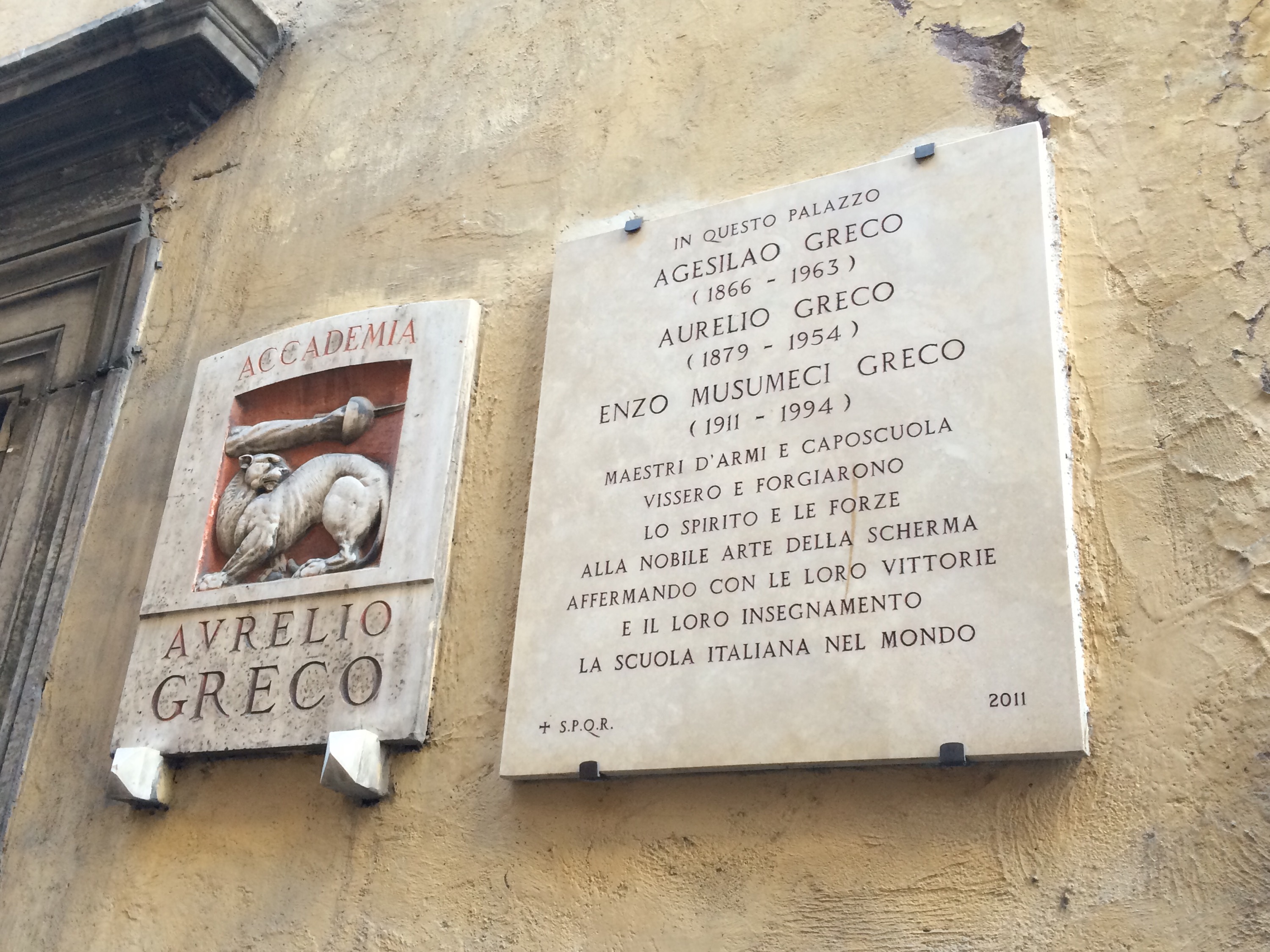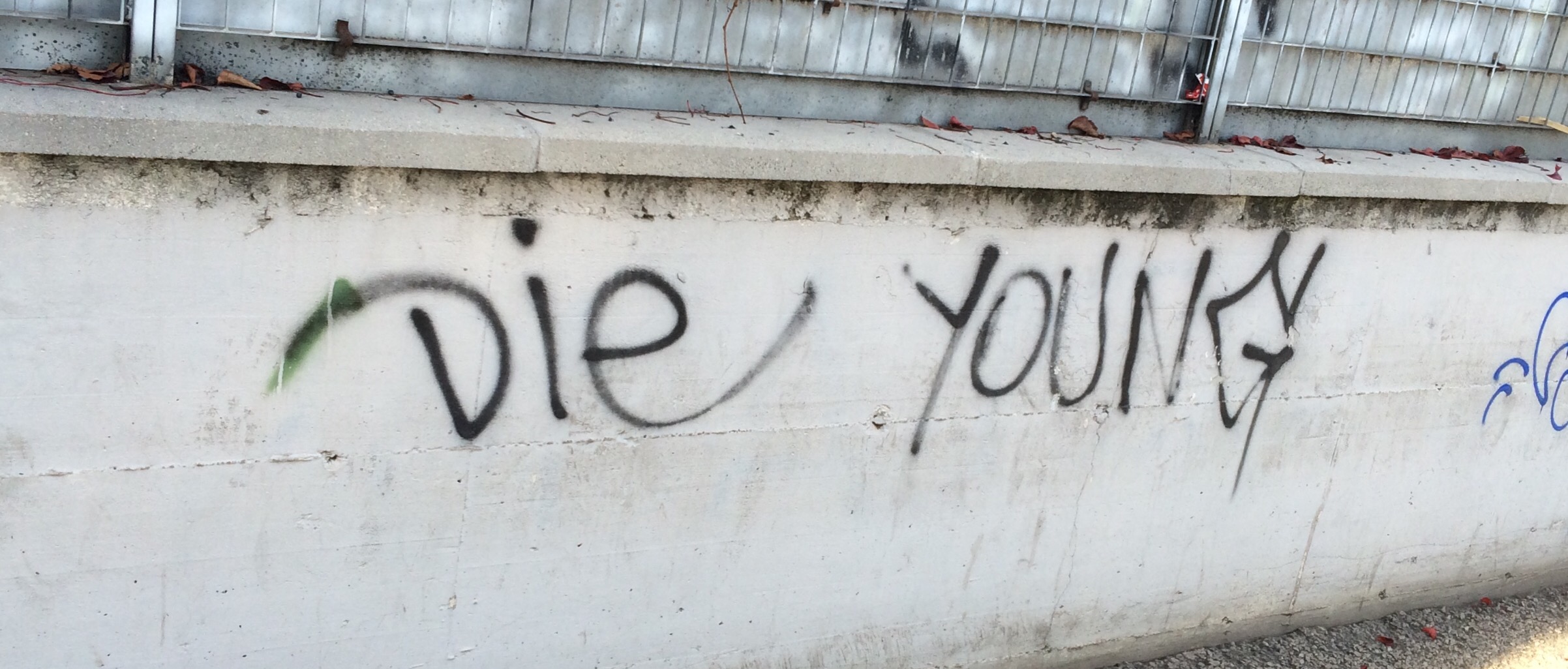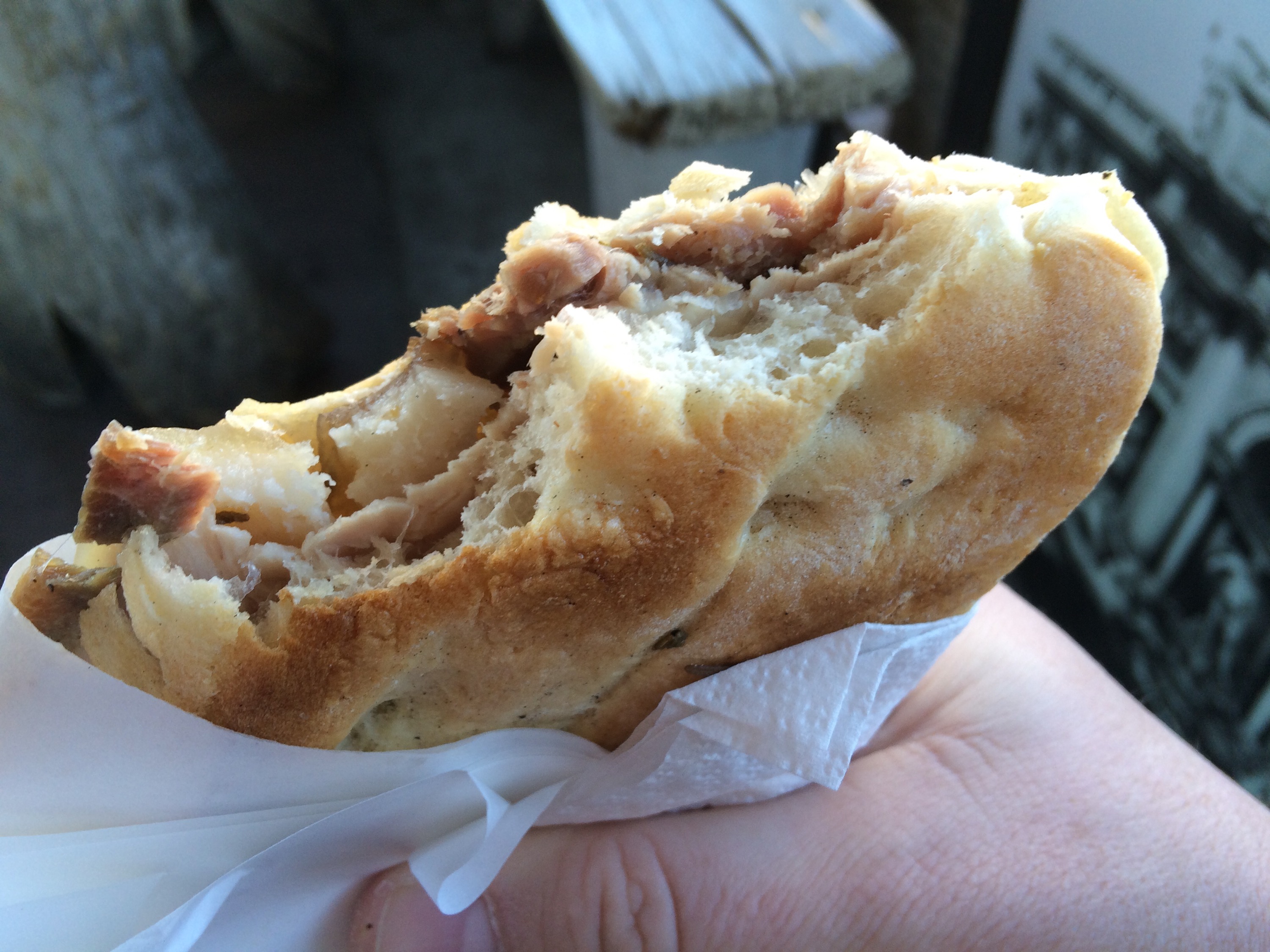-
Recent Posts
- Weekly Review January 6, 2024
- Woods September 23, 2023
- Melange September 23, 2023
- Brown September 22, 2023
- Infected September 22, 2023
- Doughnuts September 21, 2023
- Mothballed September 21, 2023
- Motownish September 20, 2023
- Far III September 19, 2023
- Far II September 19, 2023
- Far September 19, 2023
- Burbs September 16, 2023
- Celtic September 15, 2023
- Aroma September 15, 2023
- Mace September 15, 2023
- Timeless September 15, 2023
- Humidity September 15, 2023
- Hospitality September 14, 2023
- Road II September 14, 2023
- Galaxy July 23, 2023
- Jab April 11, 2021
- Lockheed April 5, 2021
- Out February 25, 2021
- International February 10, 2021
- Goat February 8, 2021
Tags
Archives
- January 2024 (1)
- September 2023 (18)
- July 2023 (1)
- April 2021 (2)
- February 2021 (3)
- January 2021 (2)
- December 2020 (1)
- November 2020 (1)
- October 2020 (1)
- September 2020 (1)
- July 2020 (3)
- June 2020 (1)
- May 2020 (1)
- April 2020 (1)
- March 2020 (4)
- January 2020 (1)
- December 2019 (1)
- November 2019 (50)
- October 2019 (4)
- September 2019 (1)
- July 2019 (6)
- June 2019 (6)
- May 2019 (4)
- April 2019 (10)
- March 2019 (10)
- February 2019 (11)
- January 2019 (17)
- December 2018 (5)
- November 2018 (89)
- October 2018 (18)
- September 2018 (28)
- August 2018 (6)
- July 2018 (3)
- June 2018 (2)
- May 2018 (9)
- April 2018 (38)
- March 2018 (96)
- February 2018 (4)
- January 2018 (11)
- December 2017 (5)
- November 2017 (7)
- October 2017 (23)
- September 2017 (15)
- August 2017 (7)
- July 2017 (3)
- June 2017 (8)
- May 2017 (1)
- April 2017 (6)
- March 2017 (10)
- February 2017 (75)
- January 2017 (64)
- December 2016 (80)
- November 2016 (45)
- October 2016 (46)
- September 2016 (12)
- August 2016 (32)
- July 2016 (35)
- June 2016 (13)
- May 2016 (18)
- April 2016 (5)
- March 2016 (8)
- February 2016 (9)
- January 2016 (16)
- December 2015 (20)
- November 2015 (21)
- October 2015 (35)
- September 2015 (12)
- August 2015 (9)
- July 2015 (24)
- June 2015 (11)
- May 2015 (39)
- April 2015 (14)
- March 2015 (14)
- February 2015 (29)
- January 2015 (31)
- December 2014 (27)
Scherma
Posted in Roma
Leave a comment
Catacomba
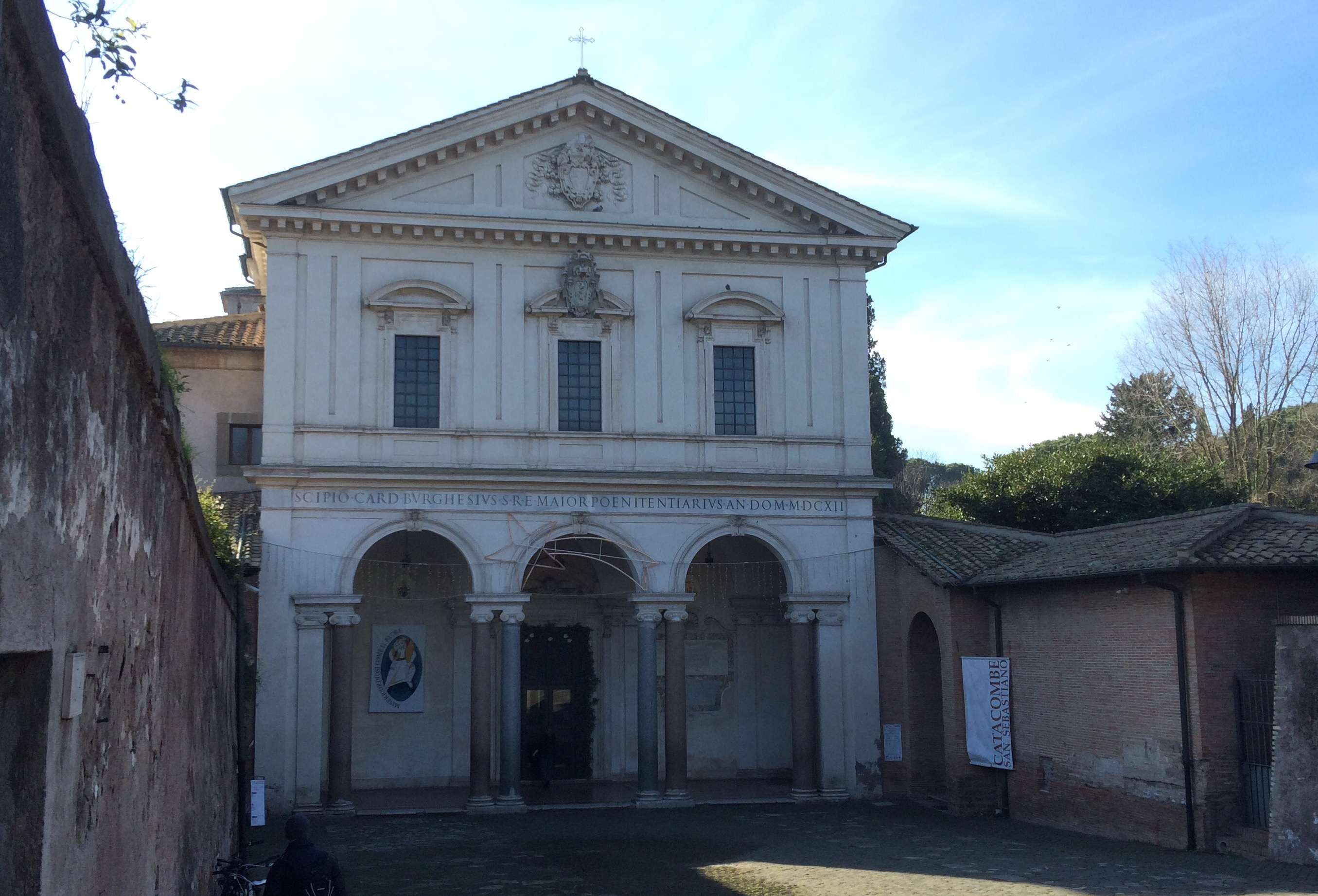 The interplay between Roman history, pagan, and Christian belief is seen throughout Rome. The catacombs of San Sebastiano are a good example.
The interplay between Roman history, pagan, and Christian belief is seen throughout Rome. The catacombs of San Sebastiano are a good example.
Now, we all now from Sandman #55 “Cerements” by Neil Gaiman that there are five methods of burial:
- Mummification (like the ancient Egyptians)
- Burning (like the late-Republic and early-Imperial Romans)
- Sky burial (like the Tibetans and some Native Americans)
- Sea burial (rare but permissible in most religions under exigent circumstances)
- Earth burial (like the early Christians in anticipation of corporeal resurrection at the Rapture)
The doctrinal need for interment — and the premium on land in Rome — is what drove the digging of Christian catacombs.
Originally, this spot along the Via Appia was a stone quarry. At the end of the 2nd century C.E., it was abandoned and repurposed for pagan burials. In addition to simple graves for slaves, three wealthy Romans families built elaborate mausoleums. But then in the 3d century, the whole thing was filled in and buried. After Constantine‘s conversion to Christianity, a church was built on top of the site and Christian burials were dug underneath into the tuff. In the case of this one church, 6 km of catacombs. (Pictures were forbidden in the catacombs, so there is nothing visual to accompany all of the above history.)
The church was later rebuilt by Scipione Borghese who had a habit of rebuilding churches and slapping his name on the front of them. But he was a great patron of Bernini, so I will give that to him.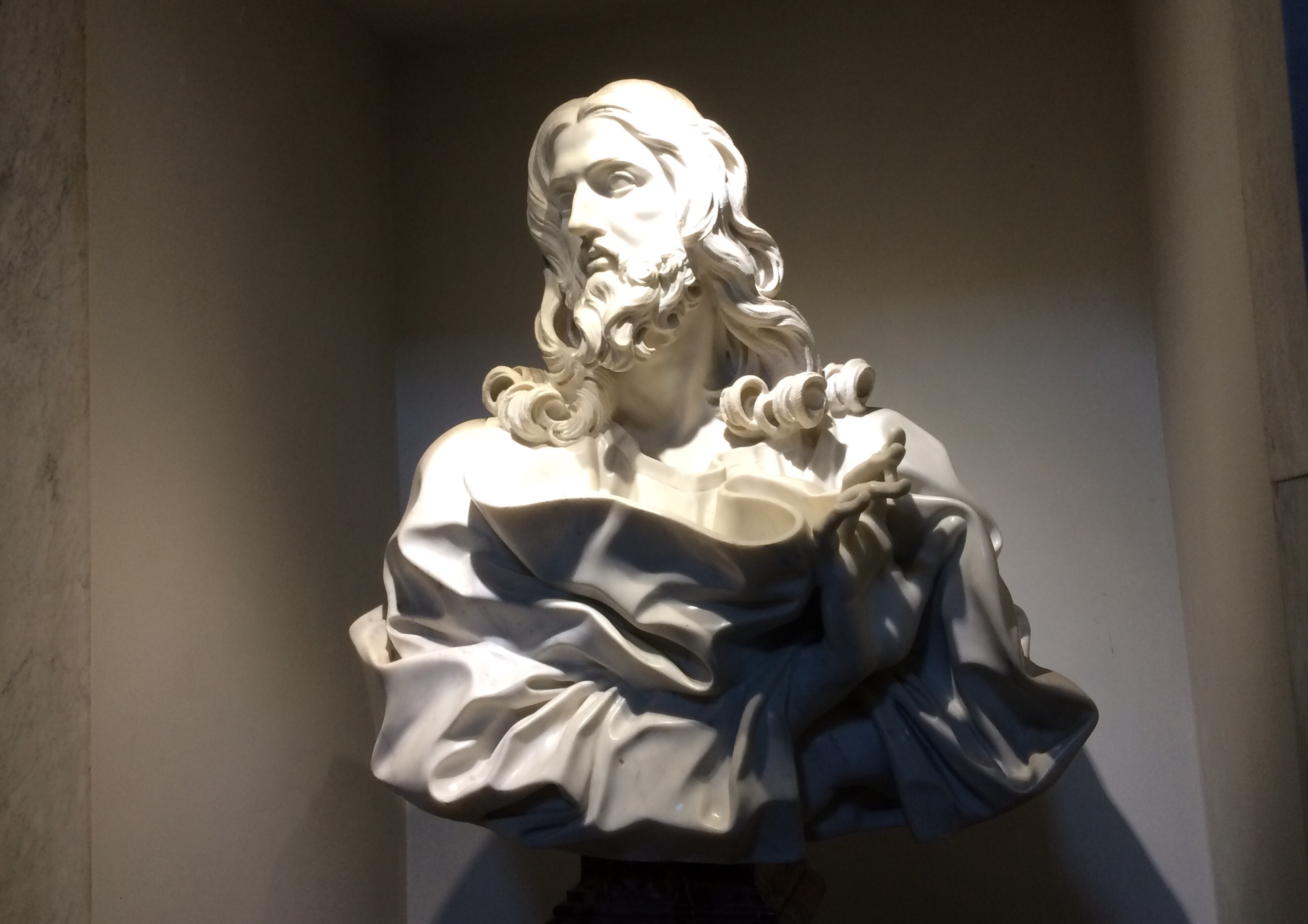 The church is home to this beautiful statue of Christ which was carved late in Bernini‘s life which is why it is widely believed that it was actually executed by his students under his supervision.
The church is home to this beautiful statue of Christ which was carved late in Bernini‘s life which is why it is widely believed that it was actually executed by his students under his supervision.
Via
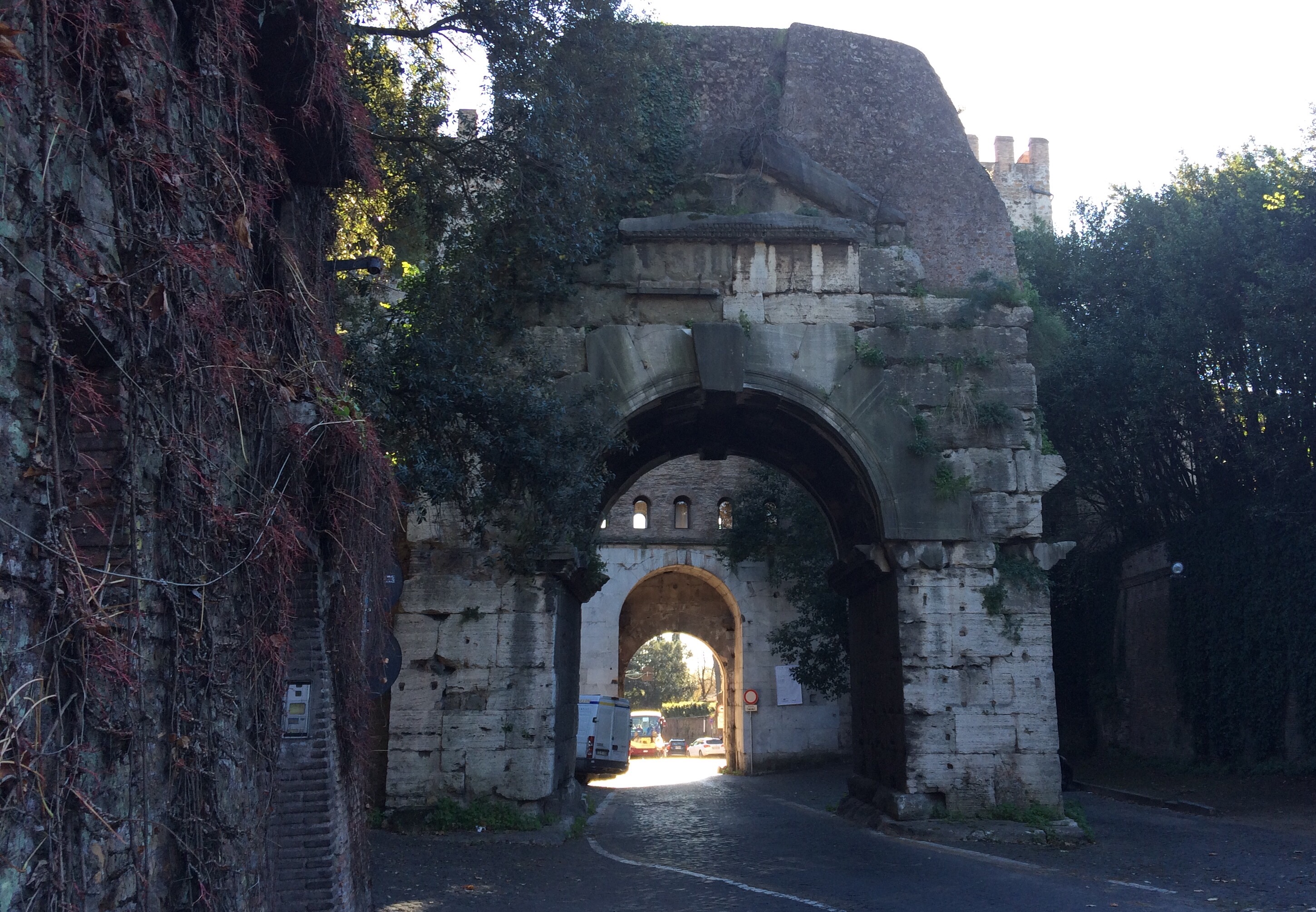 The Via Appia, looking from Rome out through the Porta Appia to the wide world beyond.
The Via Appia, looking from Rome out through the Porta Appia to the wide world beyond. I imagined embarking on a journey along this road. Heading south, toward the Mediterranean. Boarding a ship for the Levantine. Crossing the Silk Road as it spans Asia, through the Hexi Corridor, on to Xi’an.
I imagined embarking on a journey along this road. Heading south, toward the Mediterranean. Boarding a ship for the Levantine. Crossing the Silk Road as it spans Asia, through the Hexi Corridor, on to Xi’an. 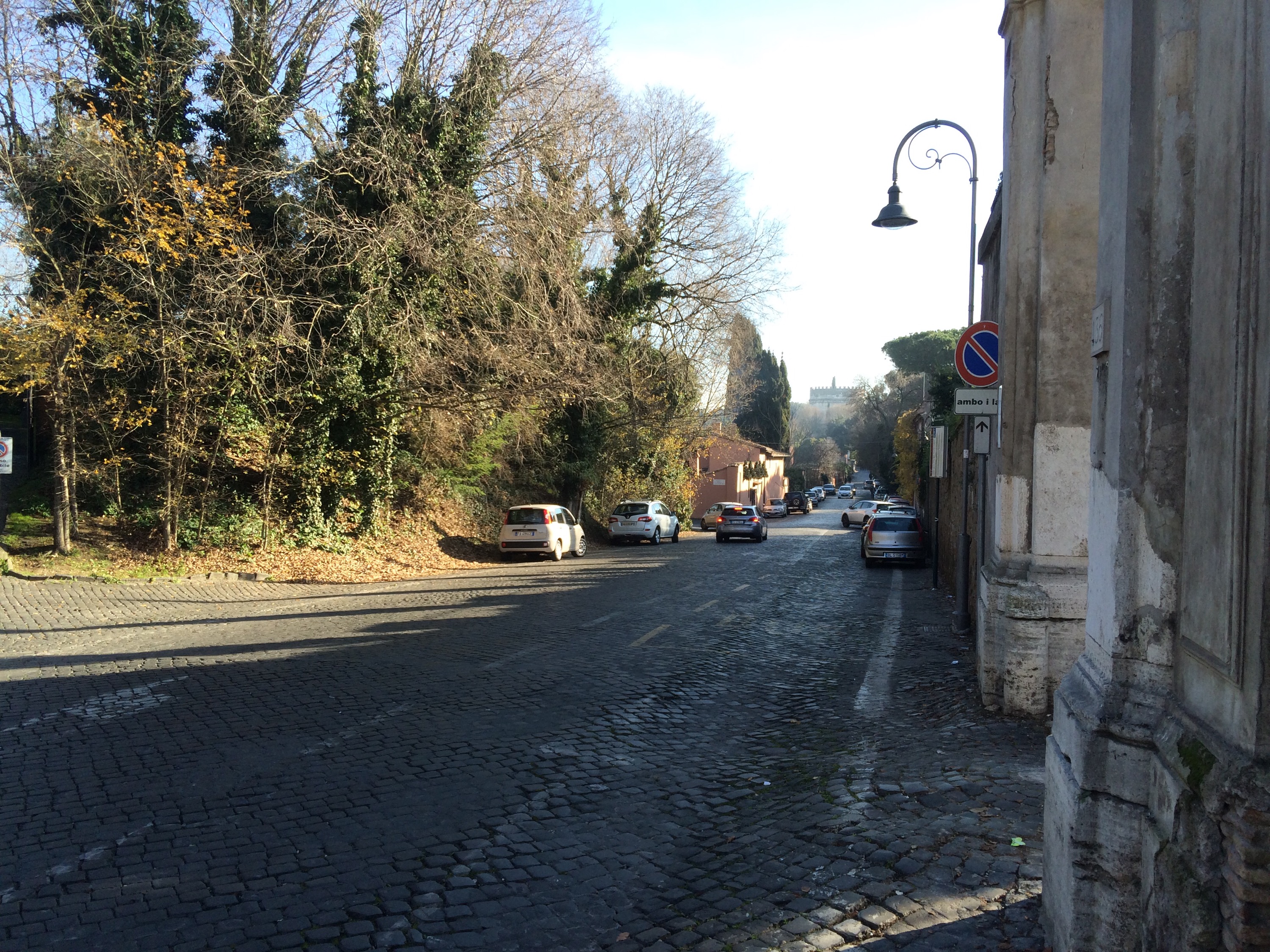 Hard to imagine this road lined with the crucifixes of Spartacus and his army.
Hard to imagine this road lined with the crucifixes of Spartacus and his army.
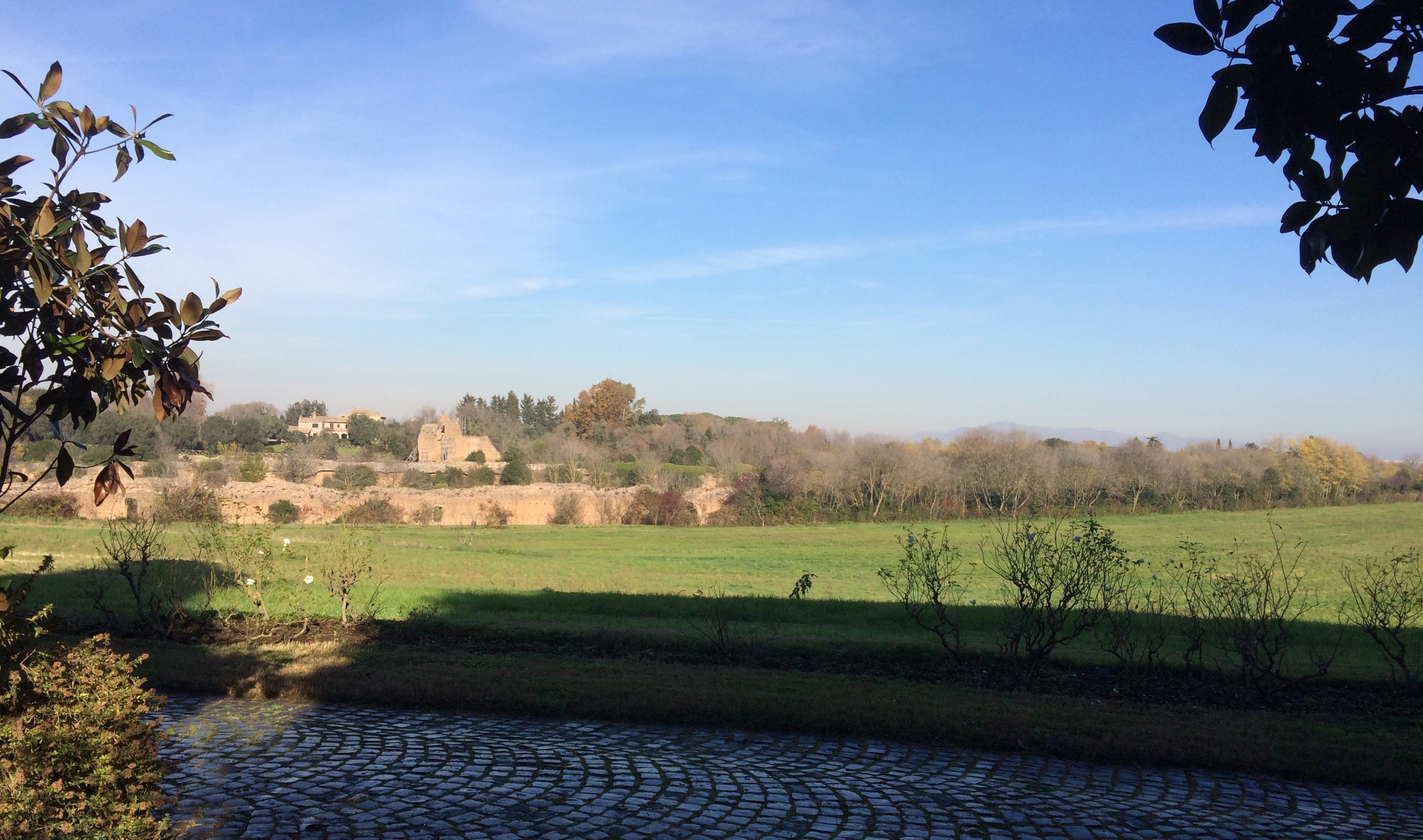 The villas and landscapes are either side of the road are breathtaking.
The villas and landscapes are either side of the road are breathtaking. 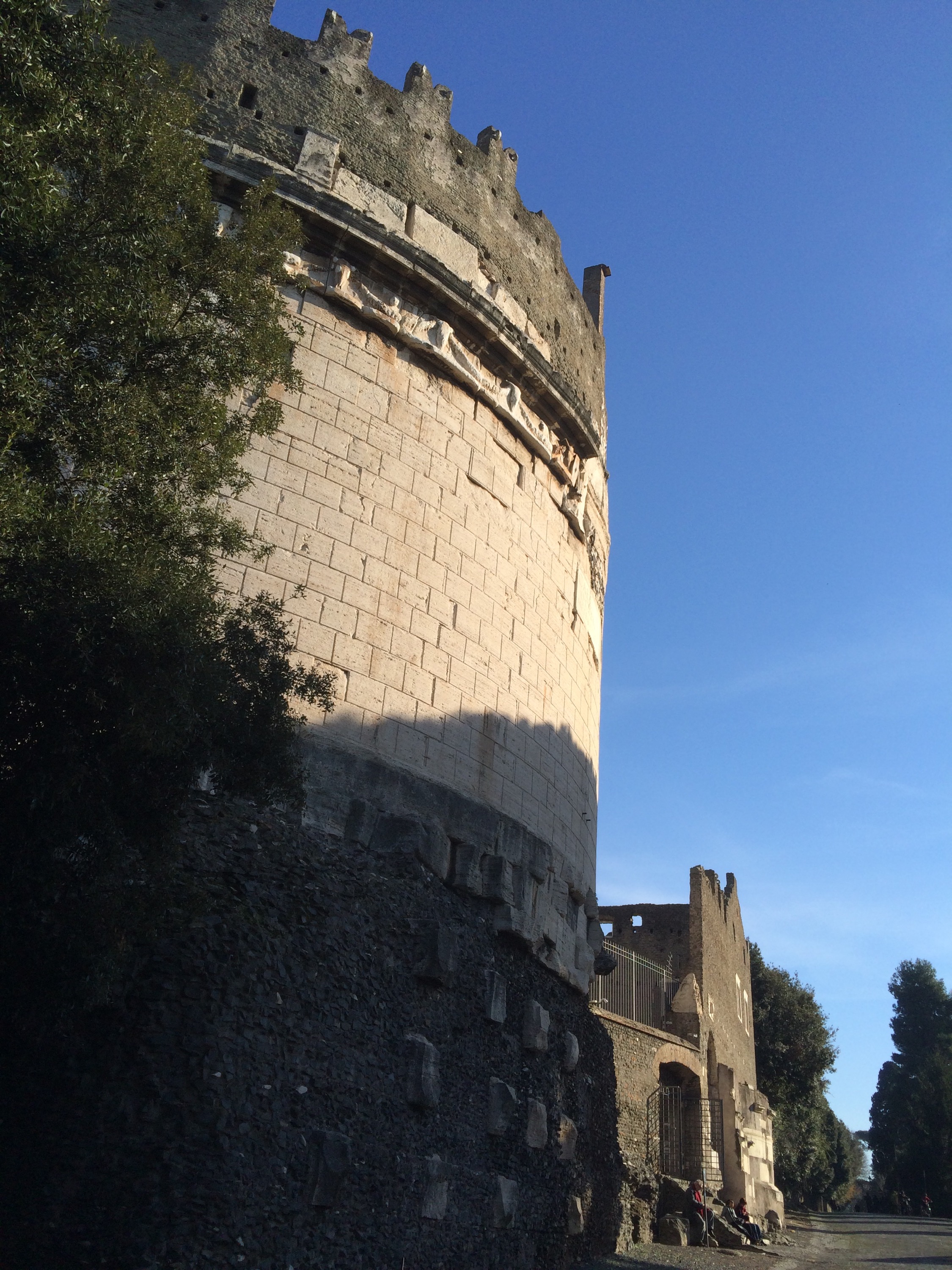
Porta II
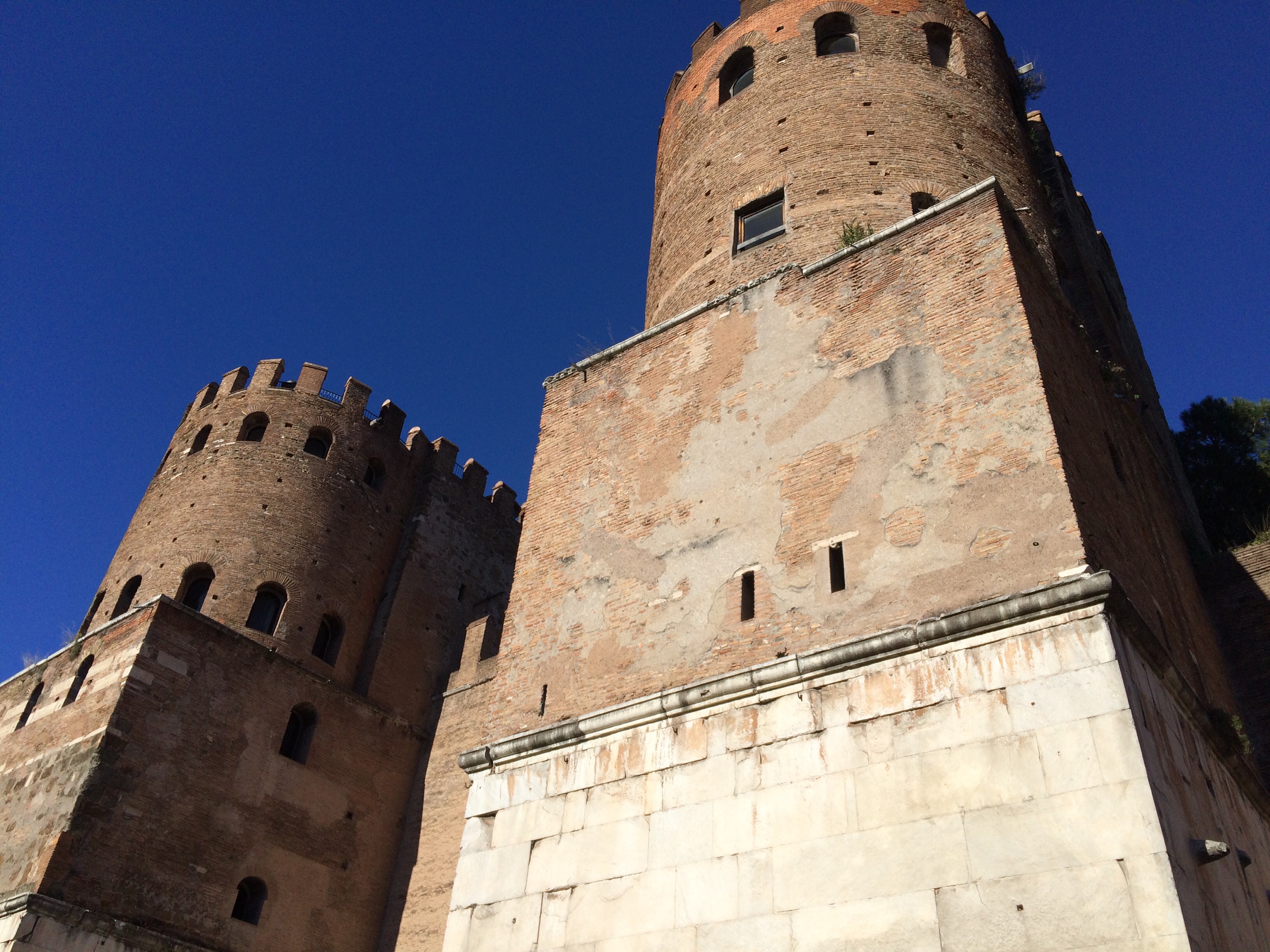 Porta San Sebastiano was the gate I was looking for.
Porta San Sebastiano was the gate I was looking for.
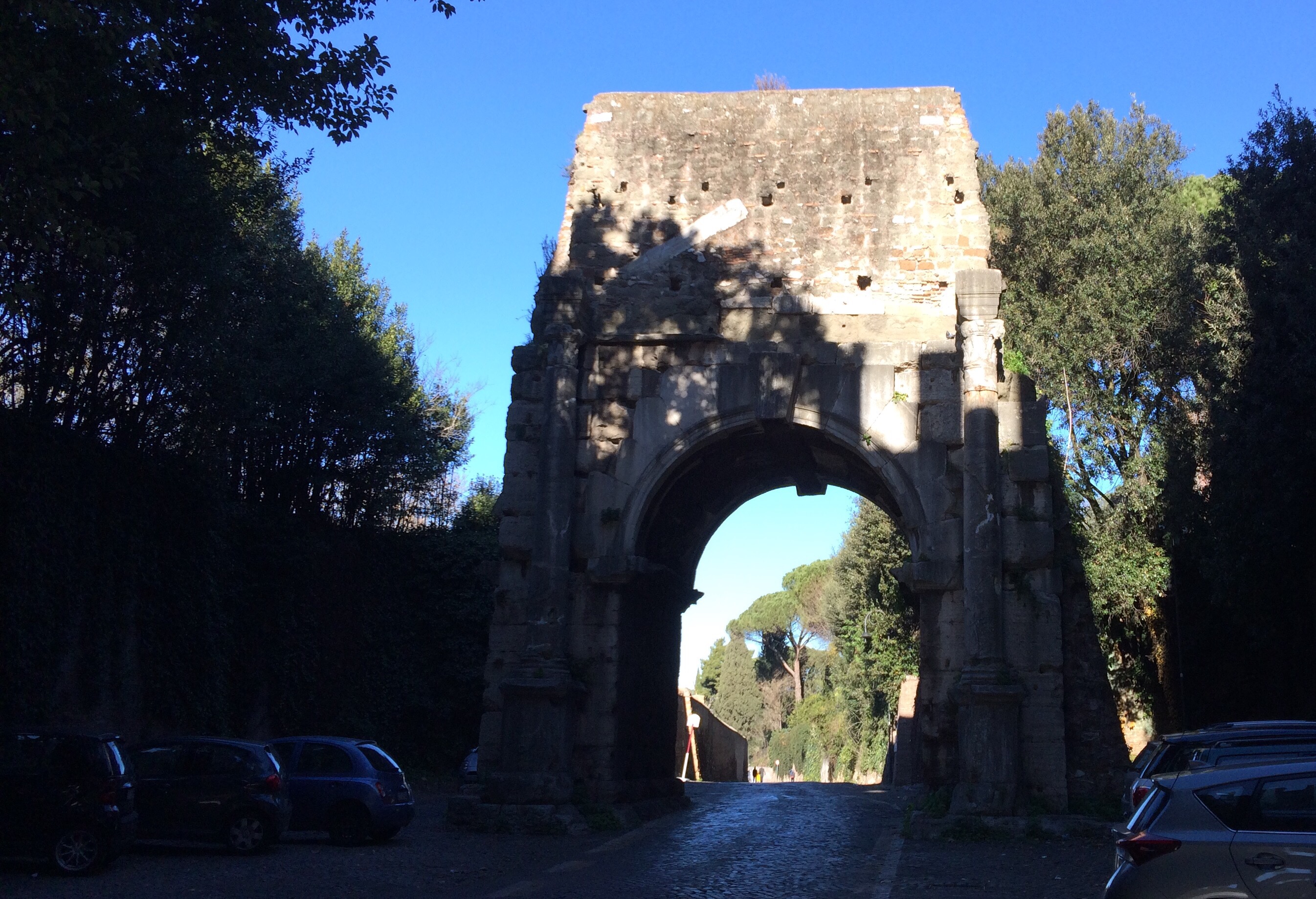 This was the old Porta Appia which stood astride the Via Appia (“Appian Way”), the most famous and important of the Roman roads.
This was the old Porta Appia which stood astride the Via Appia (“Appian Way”), the most famous and important of the Roman roads.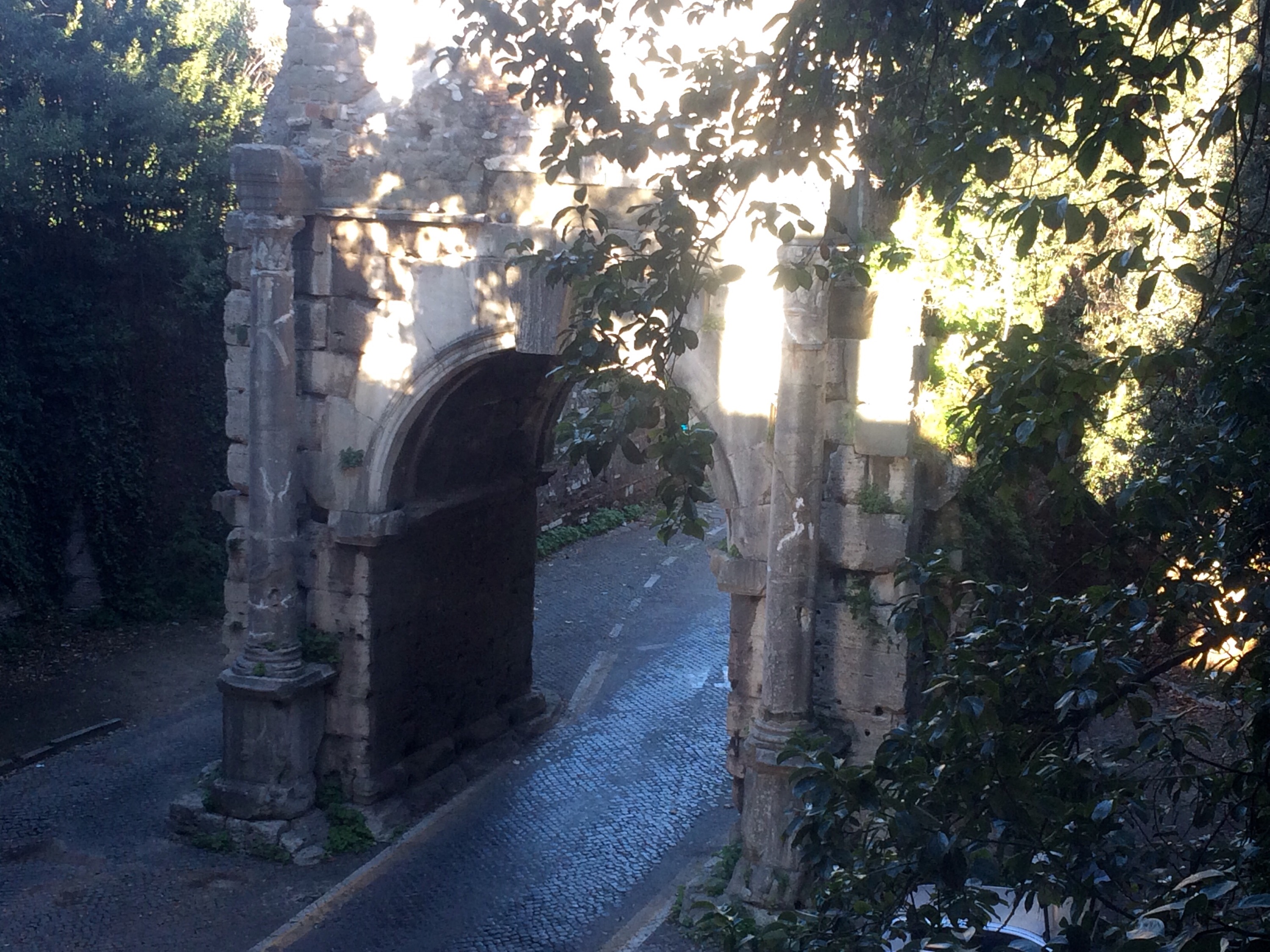 The gate is about as wide as a modern vehicle, reminding me of one of those California Redwoods you can drive a car through on the Avenue of Giants.
The gate is about as wide as a modern vehicle, reminding me of one of those California Redwoods you can drive a car through on the Avenue of Giants.
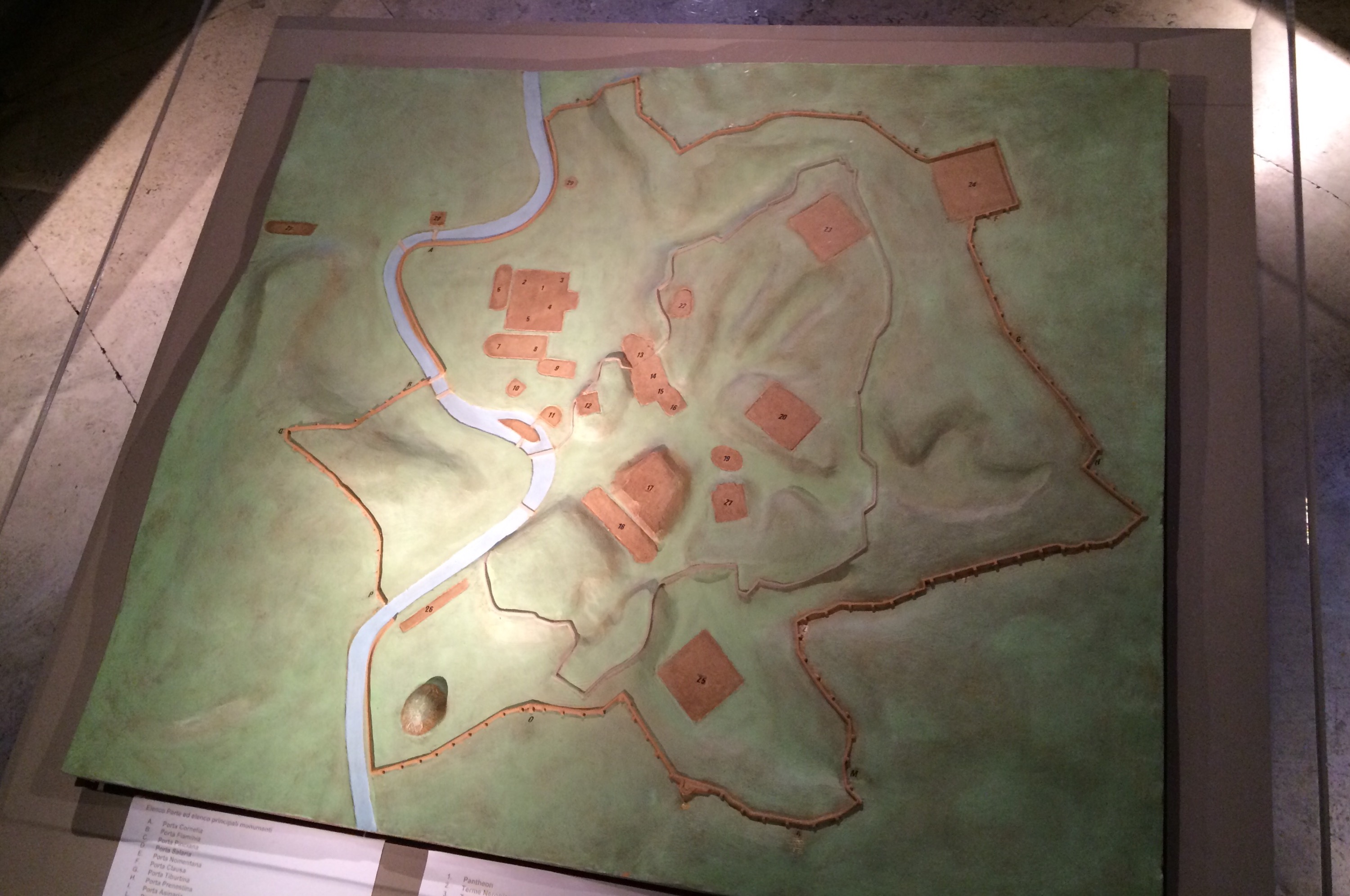 This model lays out the Aurelian Walls.
This model lays out the Aurelian Walls.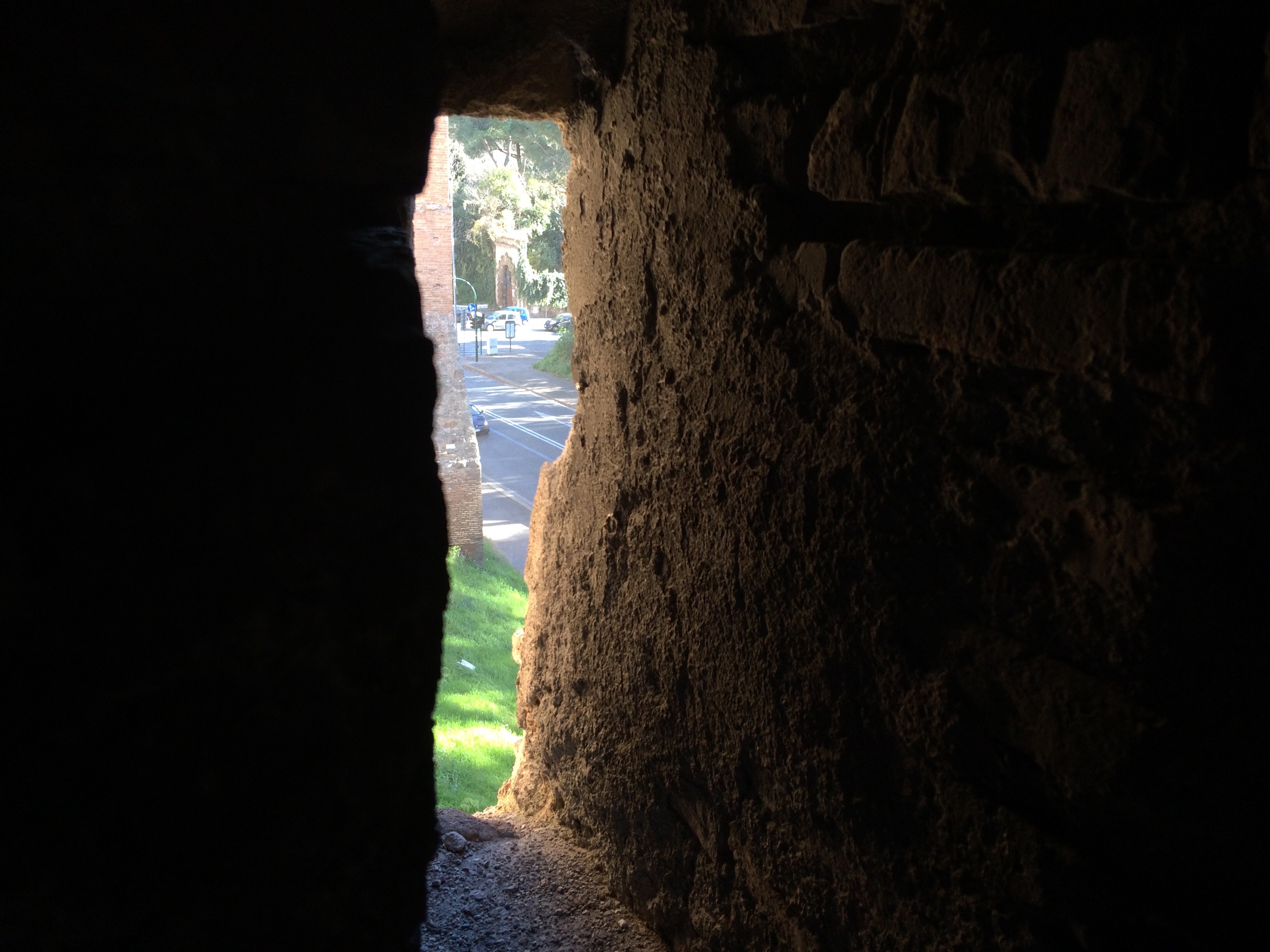 A glimpse of the Via Appia through an arrow slit in the Aurelian Walls.
A glimpse of the Via Appia through an arrow slit in the Aurelian Walls.
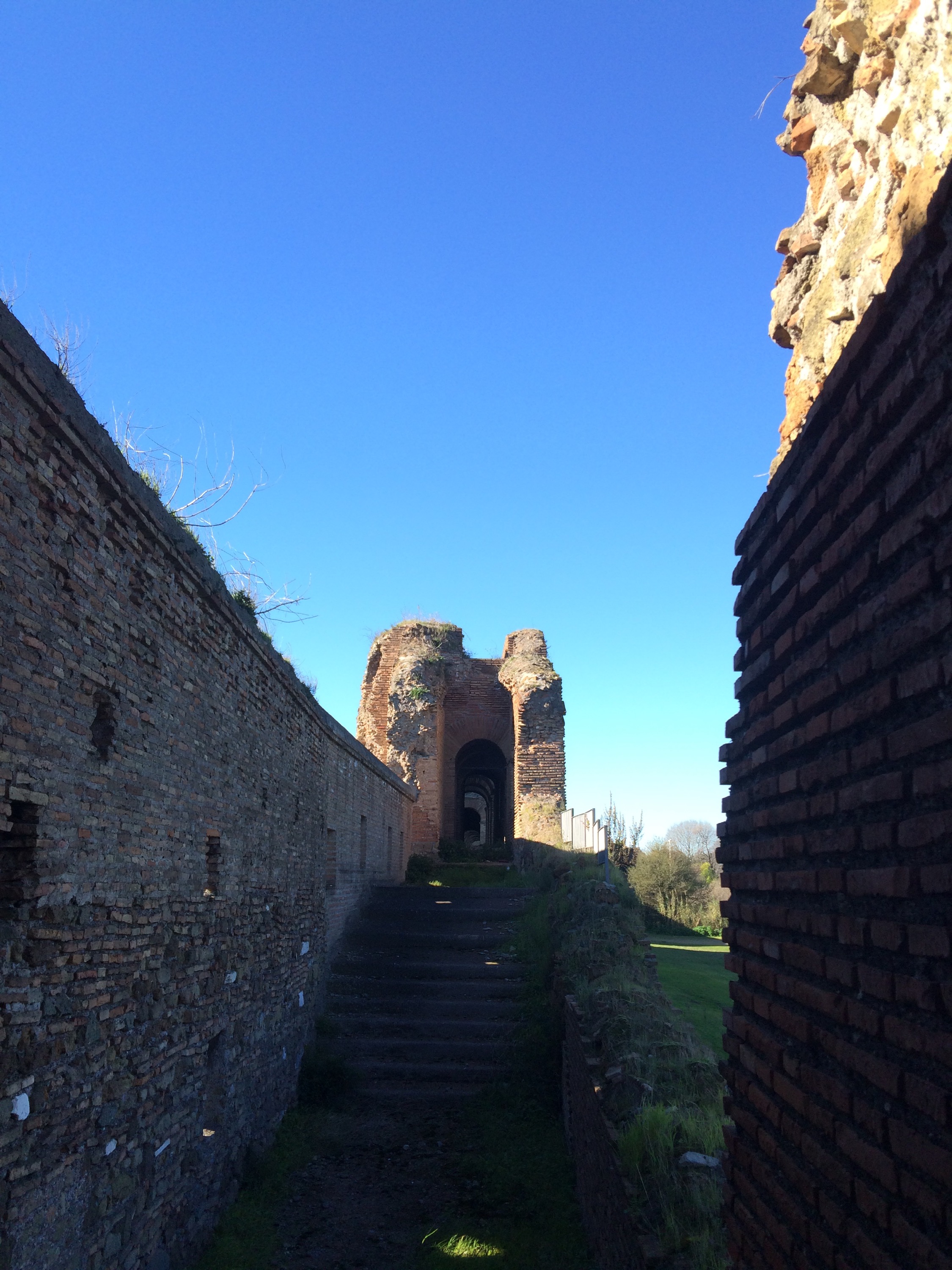
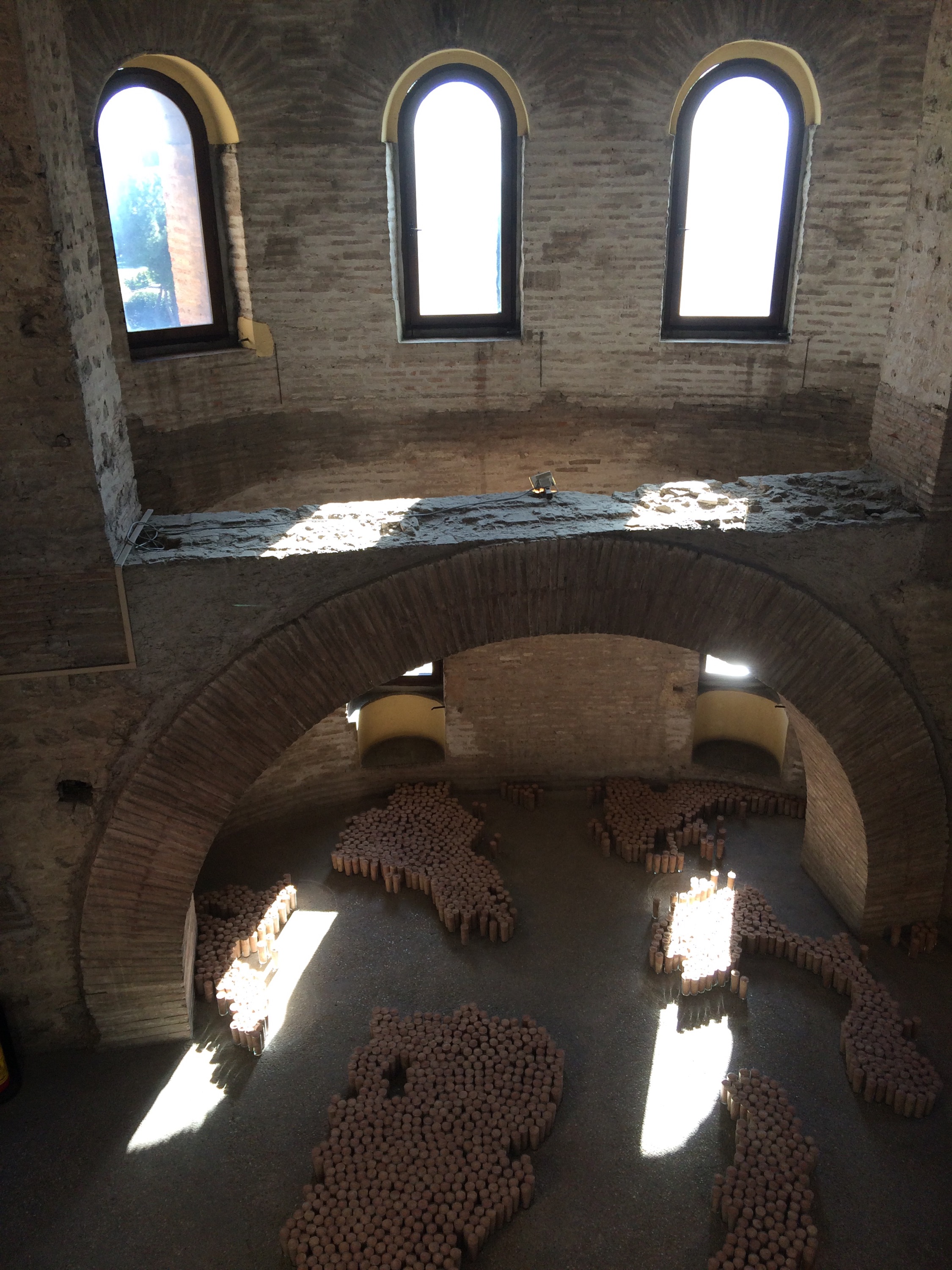
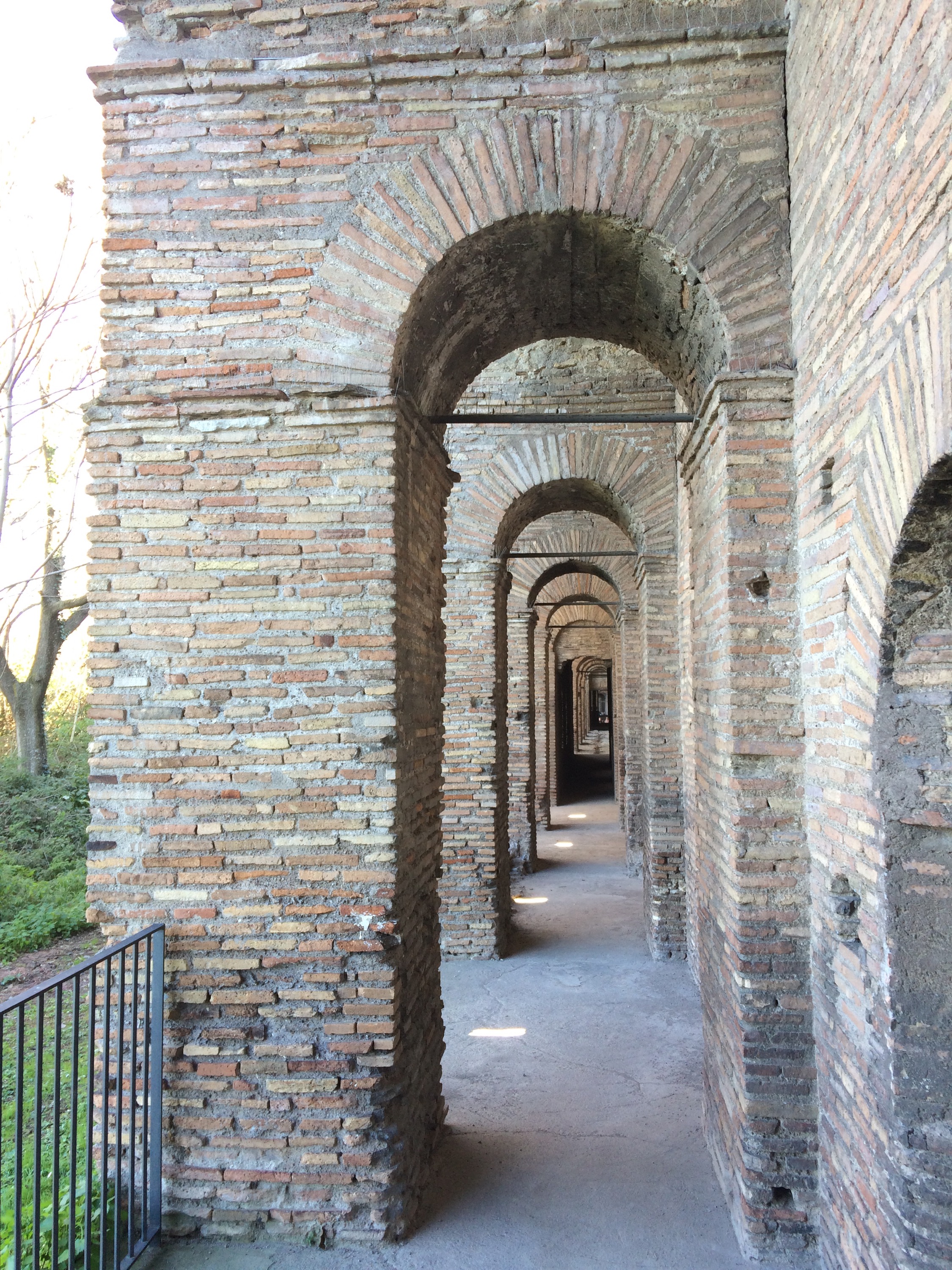
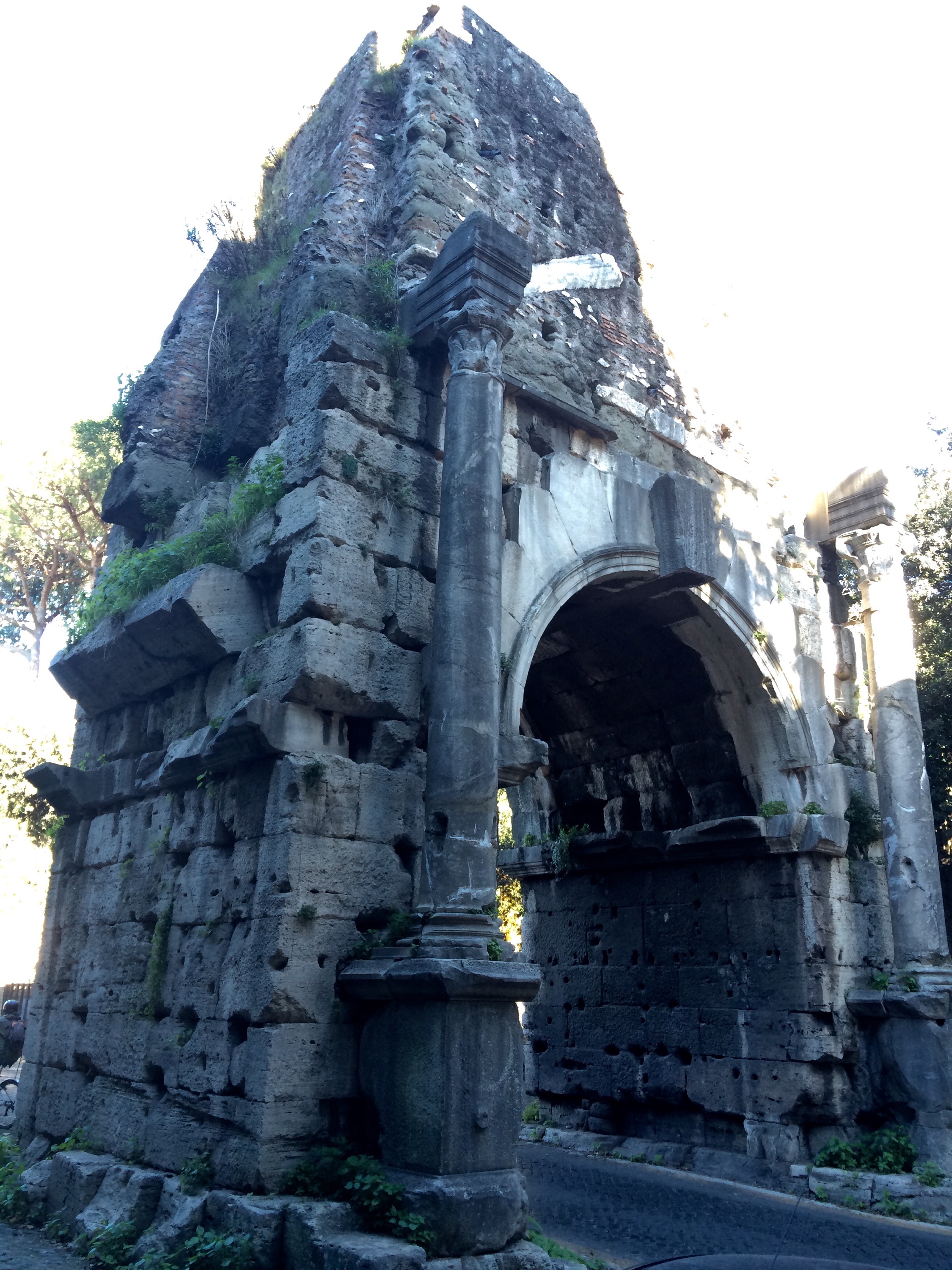
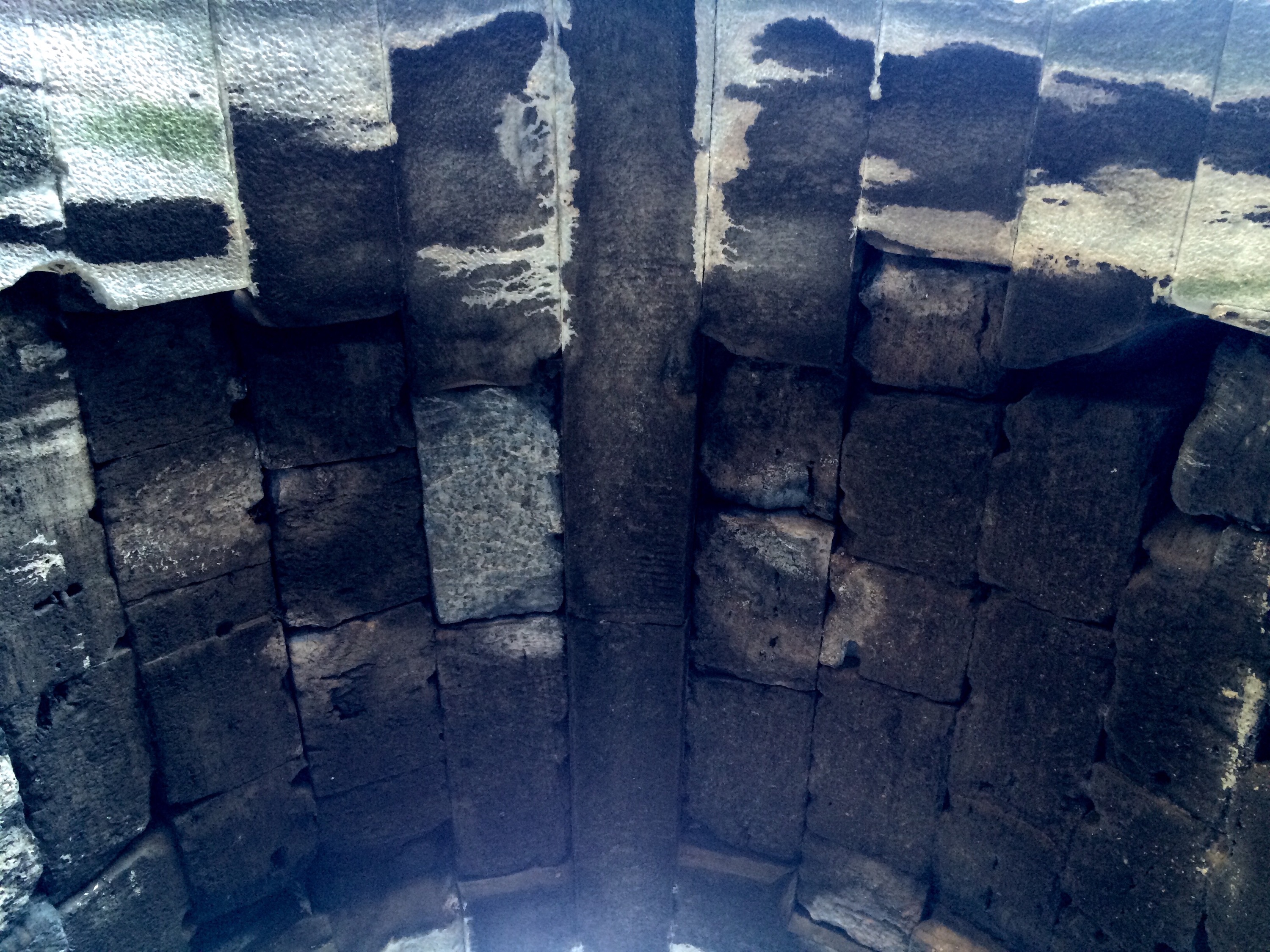 Looking straight up at the arch of the old gate.
Looking straight up at the arch of the old gate.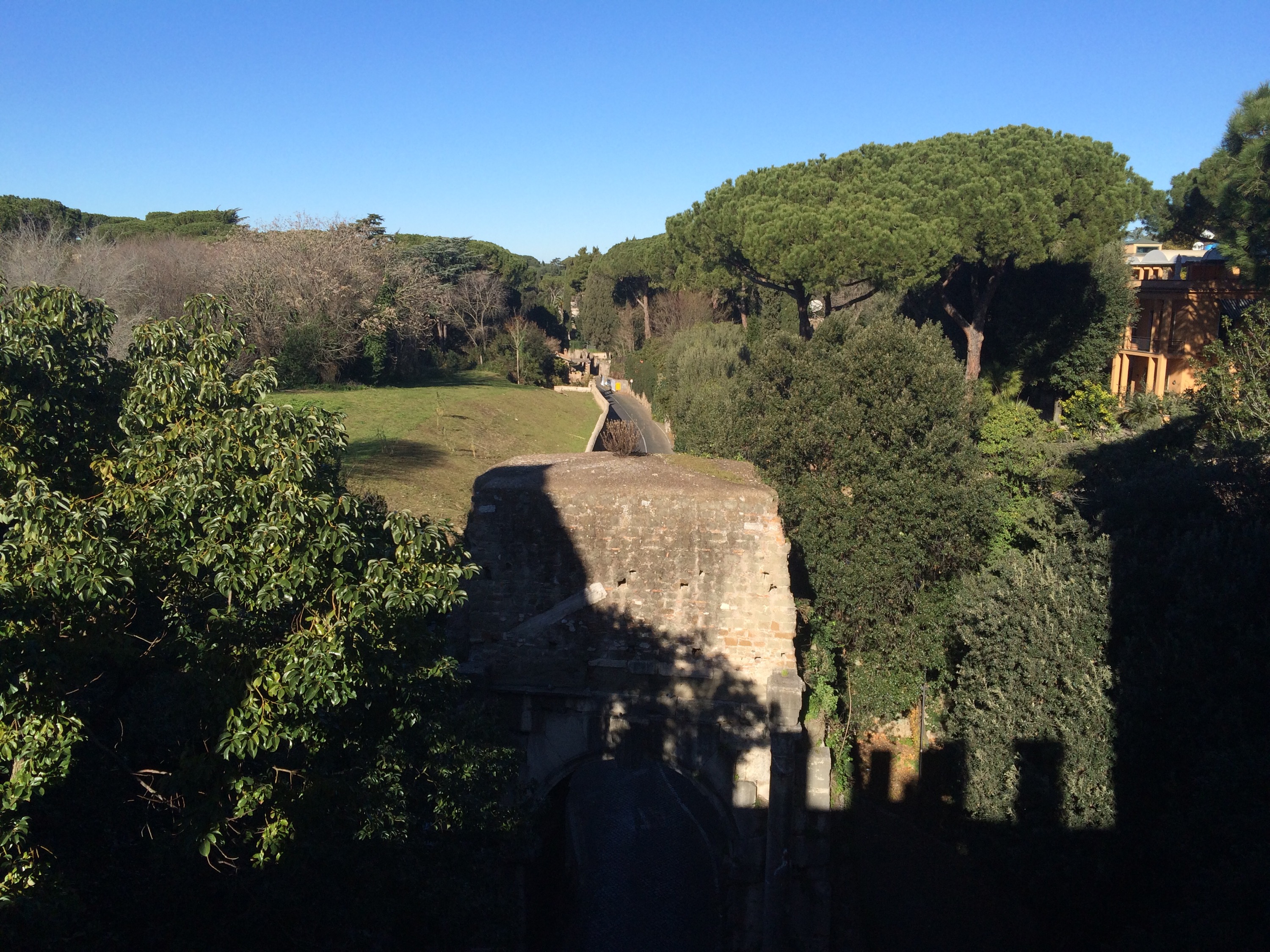 The landscape north of the gate, towards the city center, is stunning.
The landscape north of the gate, towards the city center, is stunning.
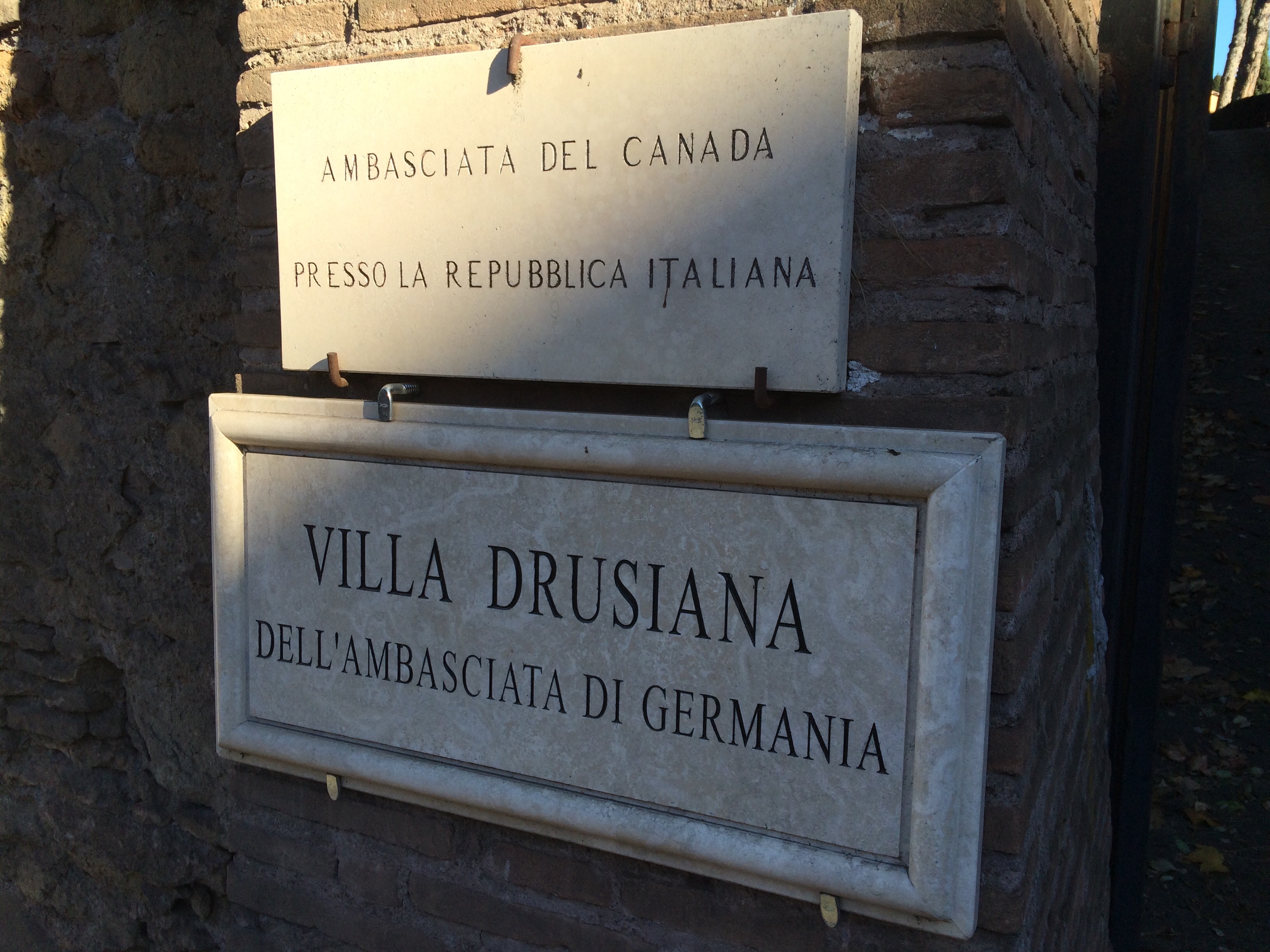 I was instantly jealous of the Germans and Canadians for having their embassies in such a beautiful, beautiful place.
I was instantly jealous of the Germans and Canadians for having their embassies in such a beautiful, beautiful place.
Porta
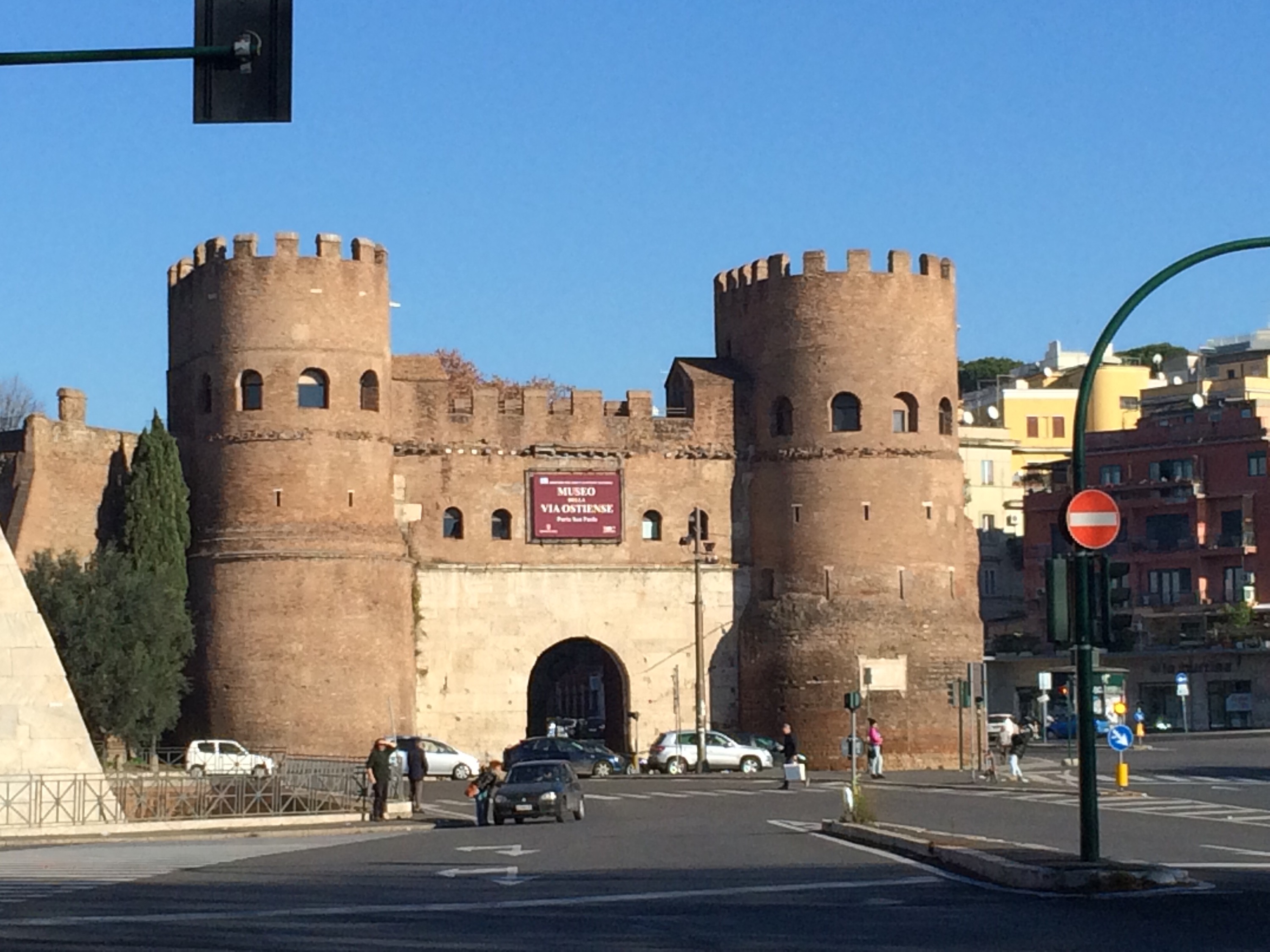 Porta San Paolo is one of the souther gates along the Aurelian Wall.
Porta San Paolo is one of the souther gates along the Aurelian Wall.
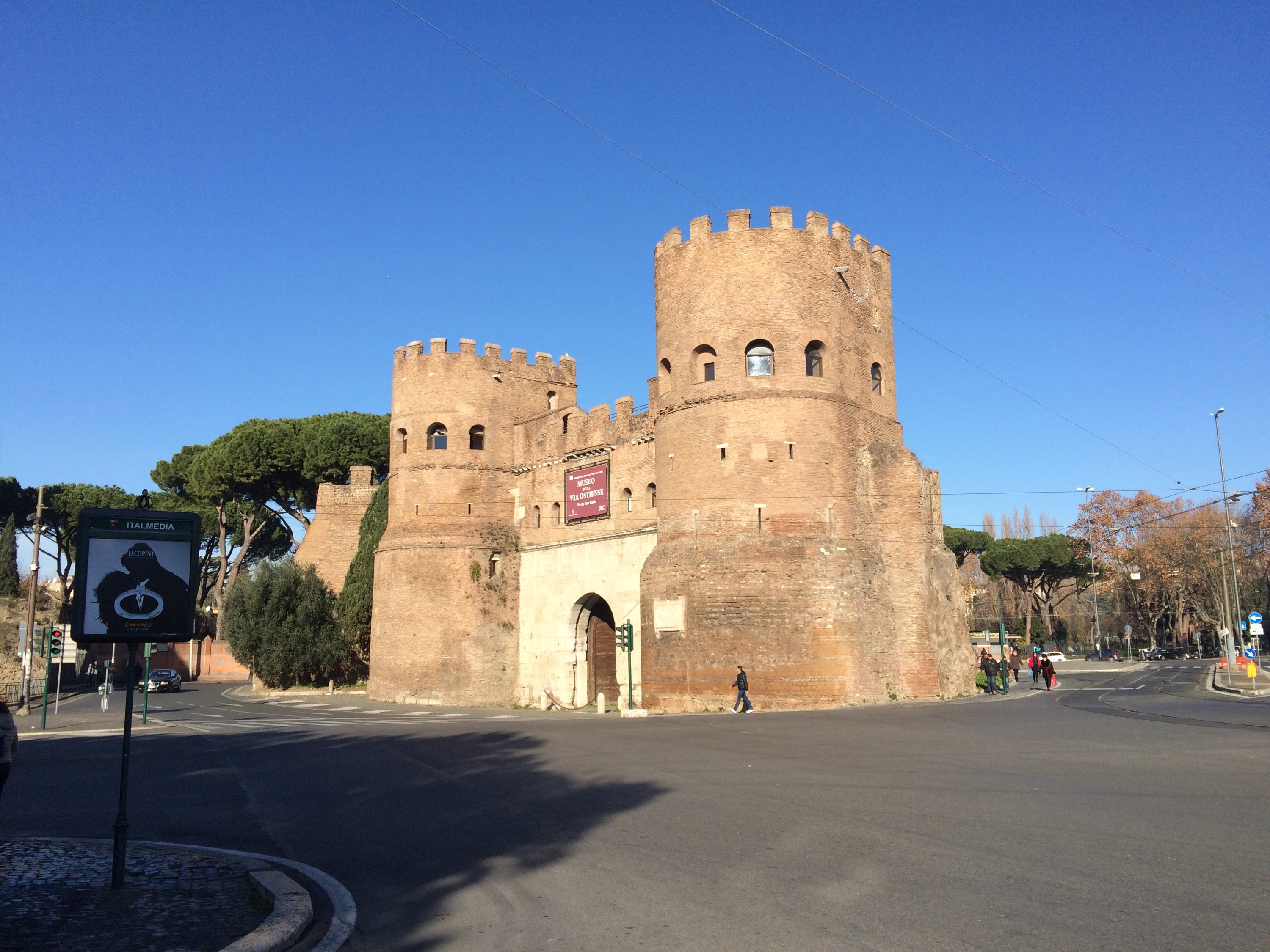 It is not to be confused with the Porta San Sebastiano which is a totally different gate and, um, the one I mistook this one for. I’m an idiot.
It is not to be confused with the Porta San Sebastiano which is a totally different gate and, um, the one I mistook this one for. I’m an idiot.
Pyramide
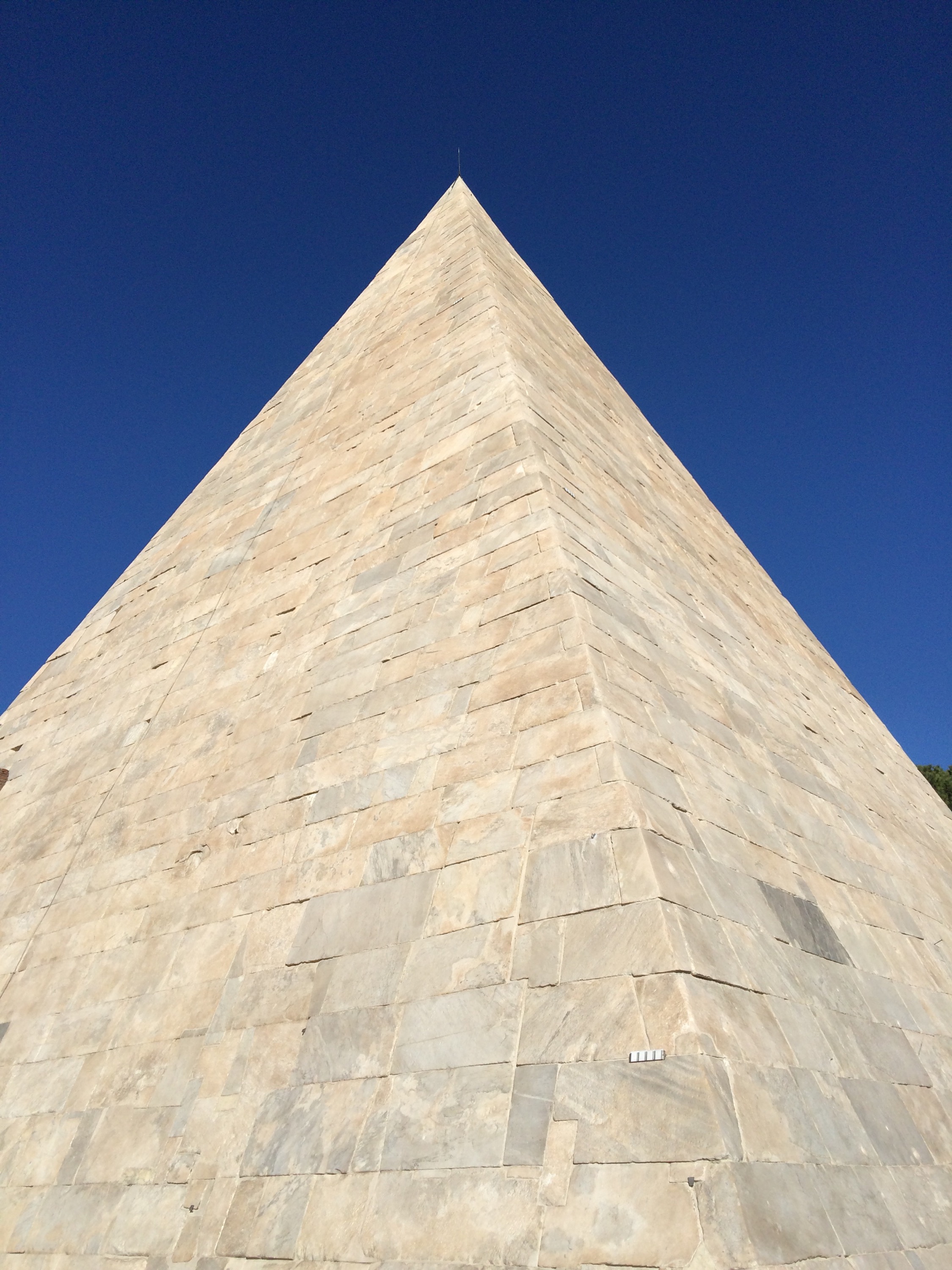 The Pyramid of Cestius was built around 12 B.C.E. to honor a magistrate and religious leader named Gaius Cestius. At least it’s not an obelisk.
The Pyramid of Cestius was built around 12 B.C.E. to honor a magistrate and religious leader named Gaius Cestius. At least it’s not an obelisk.
Posted in Roma
Leave a comment
Parete
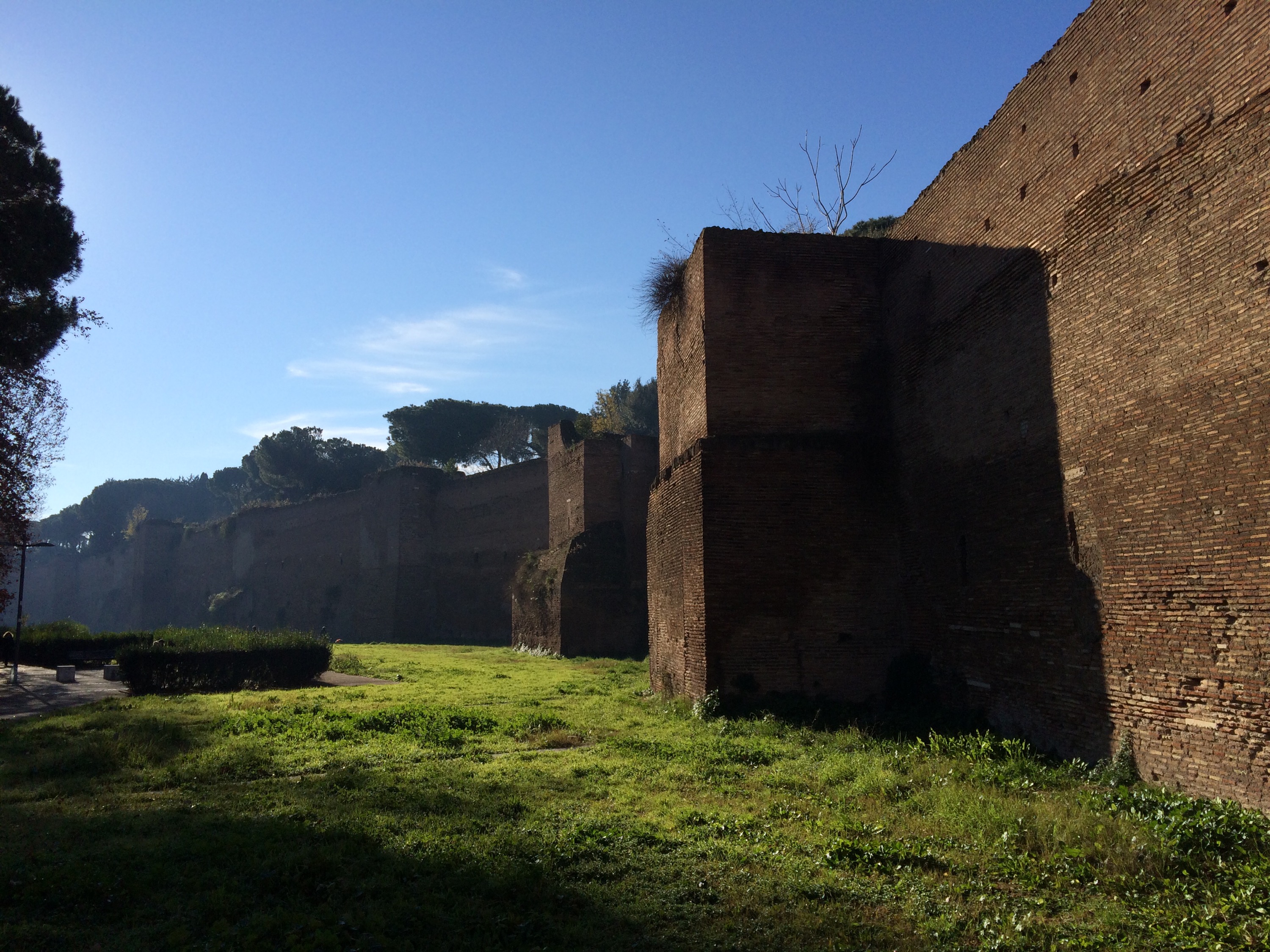 The Aurelian Walls were built between 271 and 275 C.E. during the reigns of Aurelian and Probus. They were ordered built because the city of Rome had long outgrown the old Servian Wall built in the 4th century B.C.E. (which, interestingly, did not follow the Pomerium which was the legal and religious boundary of Rome.)
The Aurelian Walls were built between 271 and 275 C.E. during the reigns of Aurelian and Probus. They were ordered built because the city of Rome had long outgrown the old Servian Wall built in the 4th century B.C.E. (which, interestingly, did not follow the Pomerium which was the legal and religious boundary of Rome.)
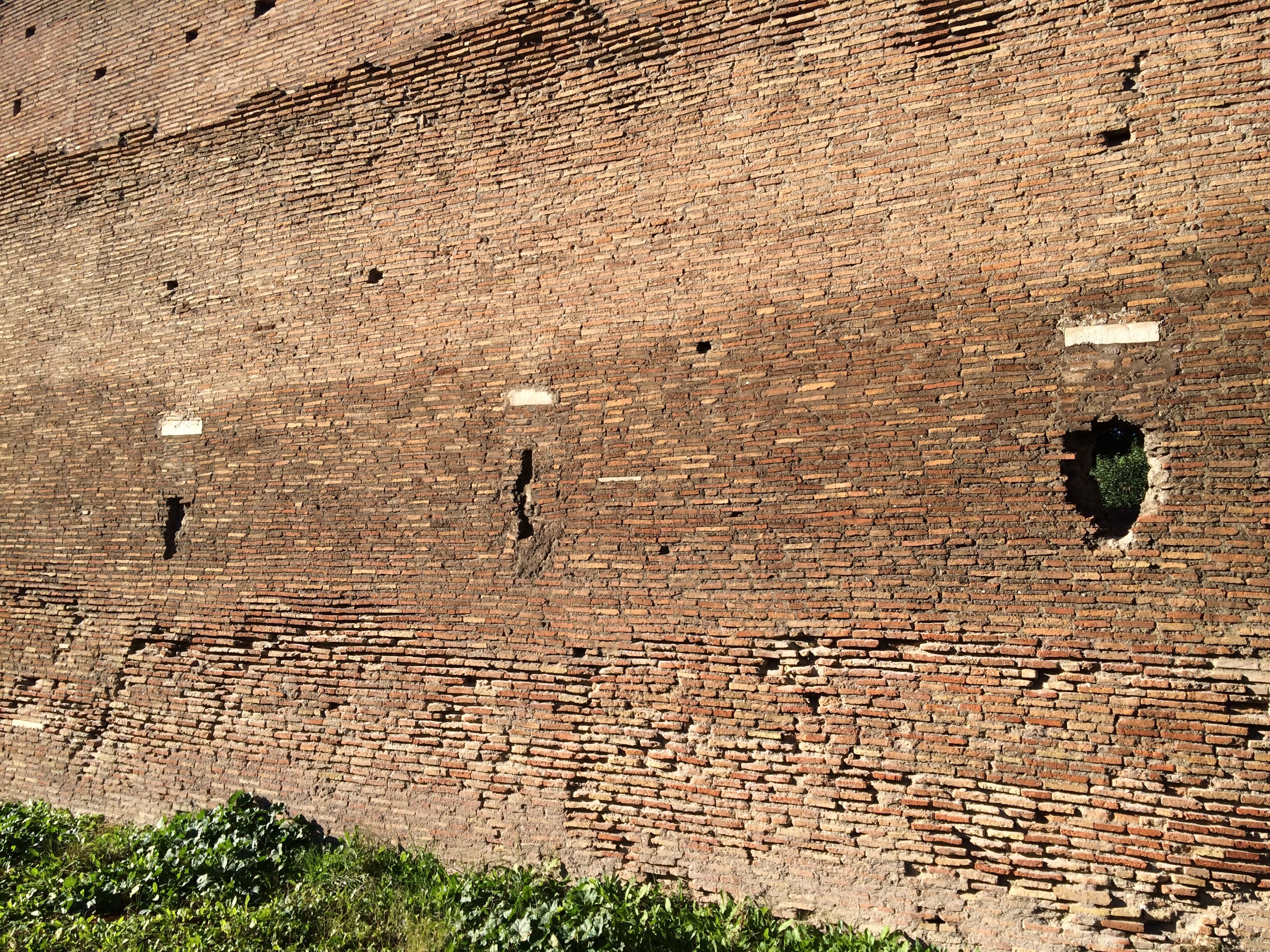 The walls reminded a bit of the city walls of Nanjing.
The walls reminded a bit of the city walls of Nanjing.
Posted in Roma
2 Comments
Biblioteca
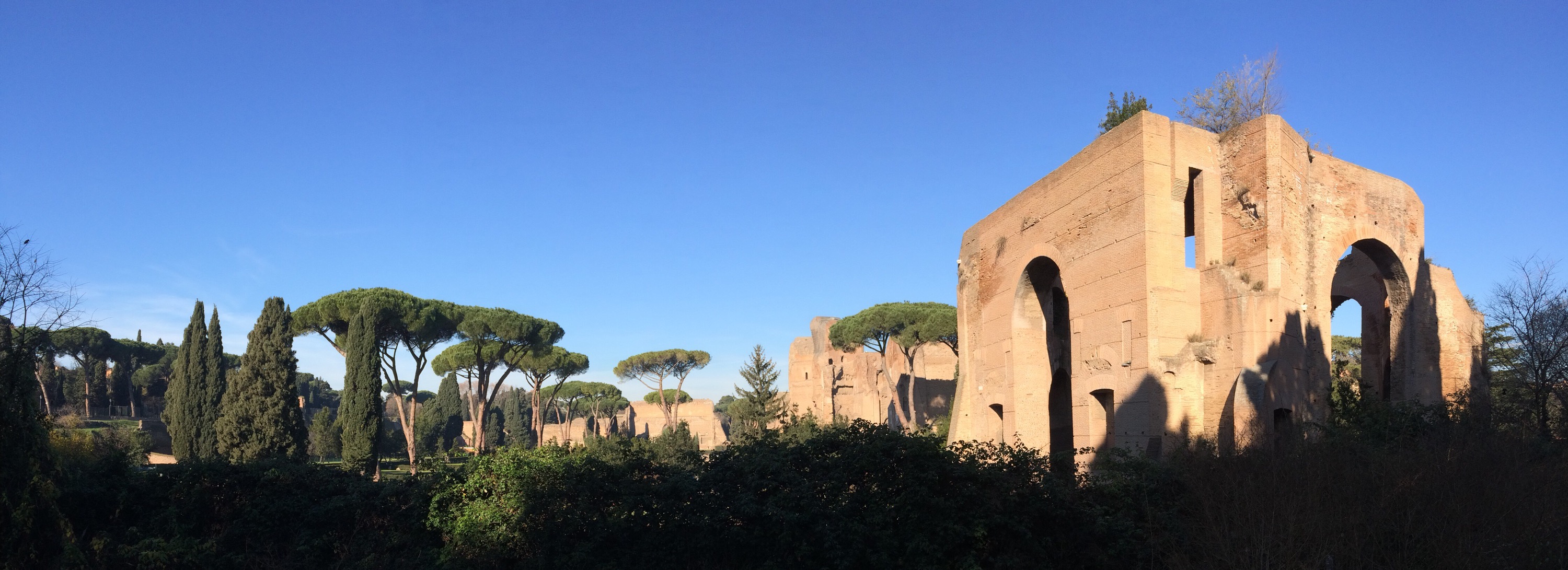 The Baths of Caracalla were the second largest of the Roman baths.
The Baths of Caracalla were the second largest of the Roman baths.
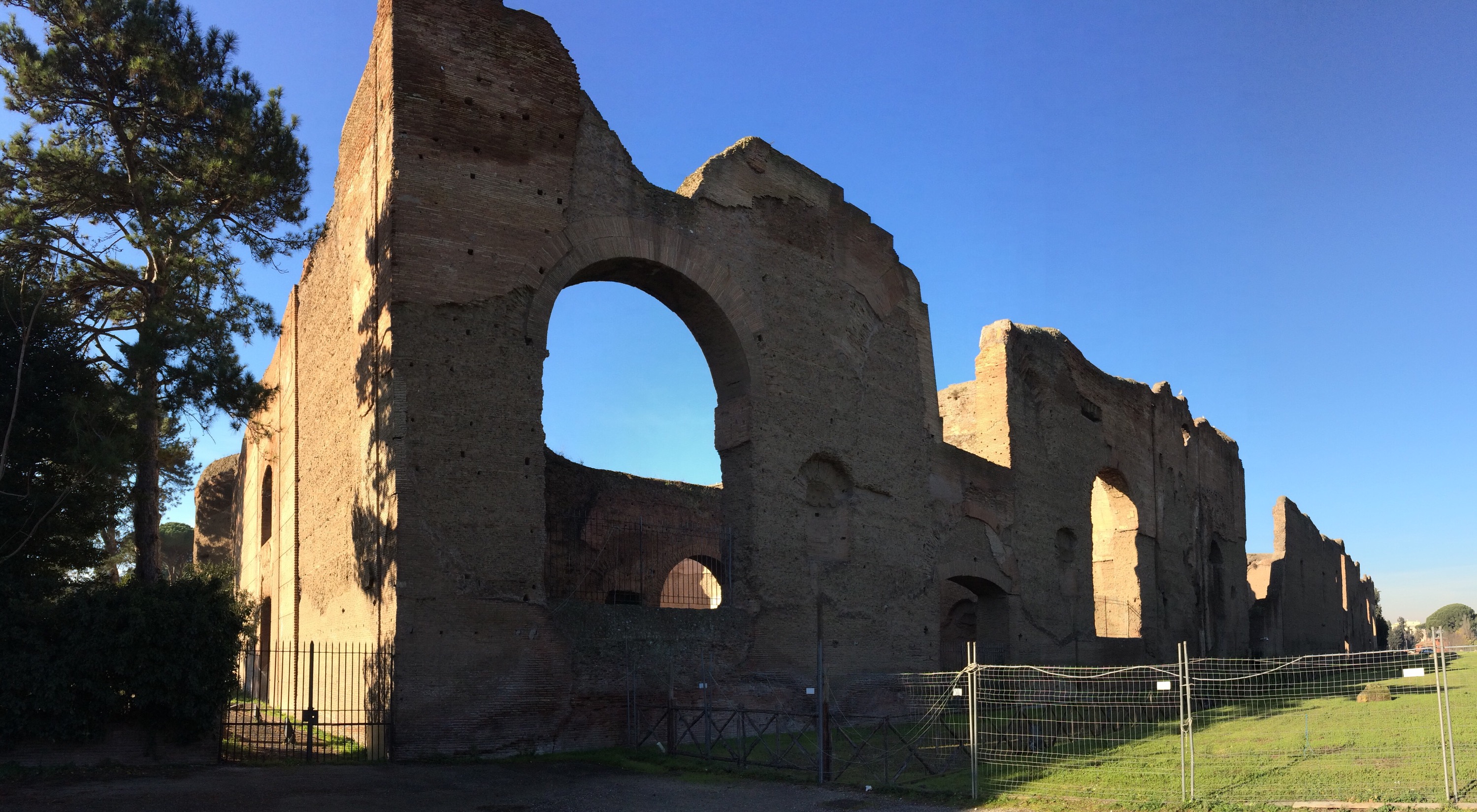 In addition to a frigidarium (“cold room”), a double pool tepidarium (
In addition to a frigidarium (“cold room”), a double pool tepidarium (
medium room”), and a caldarium (“hot room”), the complex also contained a public library. 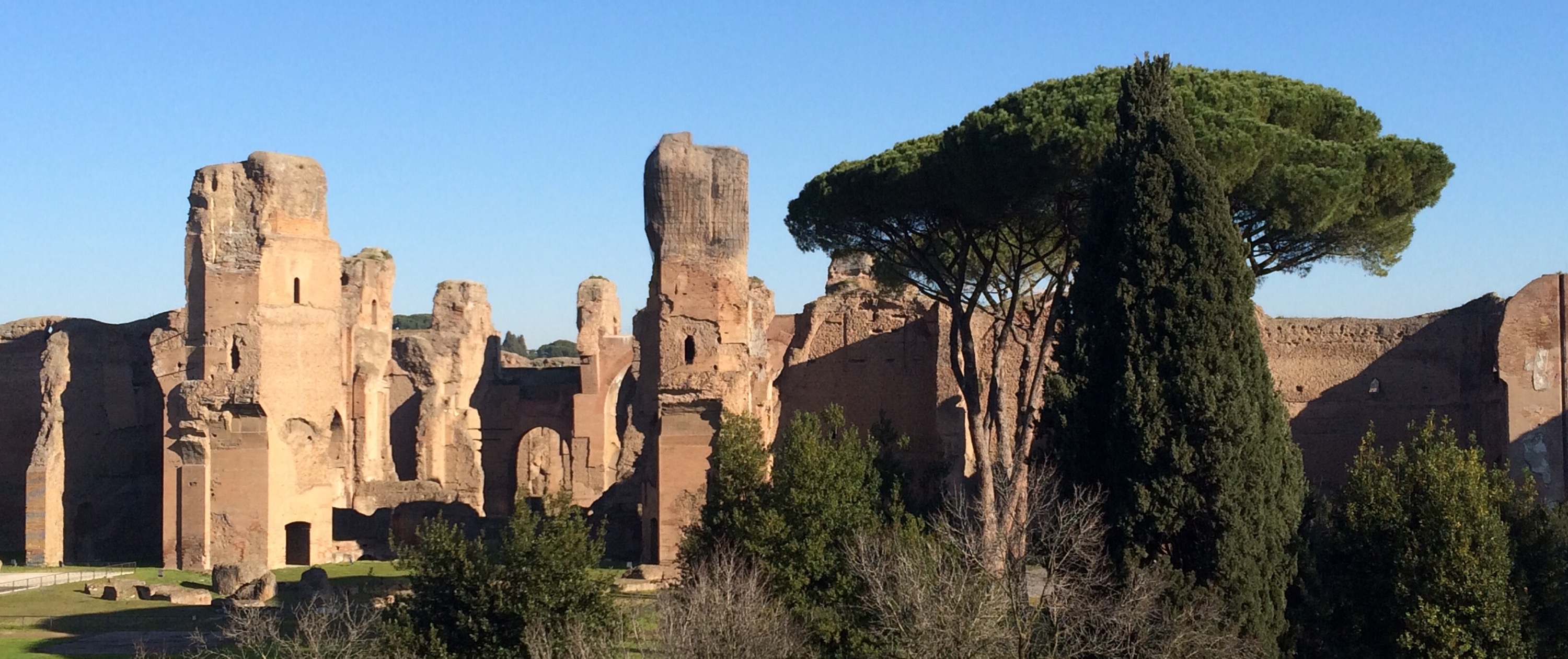 Completed in 217 C.E., the baths were still in use and in working condition until the Ostrogoth conquest in the 6th century.
Completed in 217 C.E., the baths were still in use and in working condition until the Ostrogoth conquest in the 6th century.
Freddo
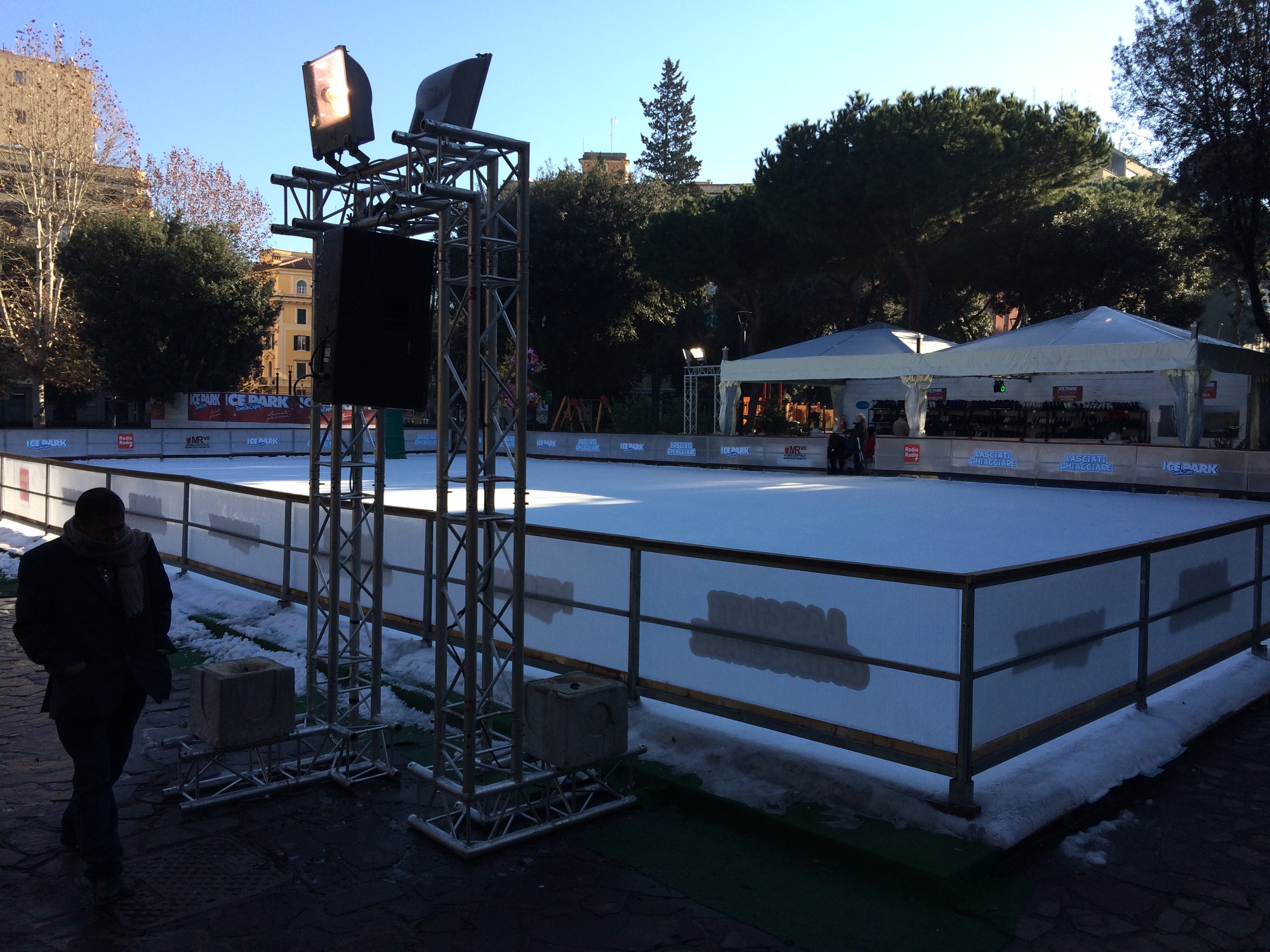 I was coming up the escalator from the train platform at Re di Roma and the Metro station was cold. Really cold. Like, cold even for me. I couldn’t figure out why this was station was such a thermal anomaly until I got aboveground and saw that a temporary ice skating rink had been constructed directly on top of it. Mystery solved.
I was coming up the escalator from the train platform at Re di Roma and the Metro station was cold. Really cold. Like, cold even for me. I couldn’t figure out why this was station was such a thermal anomaly until I got aboveground and saw that a temporary ice skating rink had been constructed directly on top of it. Mystery solved.
Posted in Roma
Leave a comment
Residenza
 The Palazzo dei Quirinal — or, colloquially, just Quirinale — is sort of the White House of Italy but way, way, way bigger. It’s the official residence of the President of the Italian Republic and sits atop the highest of the Seven Hills of Rome.
The Palazzo dei Quirinal — or, colloquially, just Quirinale — is sort of the White House of Italy but way, way, way bigger. It’s the official residence of the President of the Italian Republic and sits atop the highest of the Seven Hills of Rome. In front is a statue of the twin brothers Pollux and Castor (as in the two brightest stars of & inspiration for the constellation Gemini) taming horses. Plus another Roman obelisk. Because you gotta have an obelisk.
In front is a statue of the twin brothers Pollux and Castor (as in the two brightest stars of & inspiration for the constellation Gemini) taming horses. Plus another Roman obelisk. Because you gotta have an obelisk.
Posted in Roma
2 Comments
Fontana II
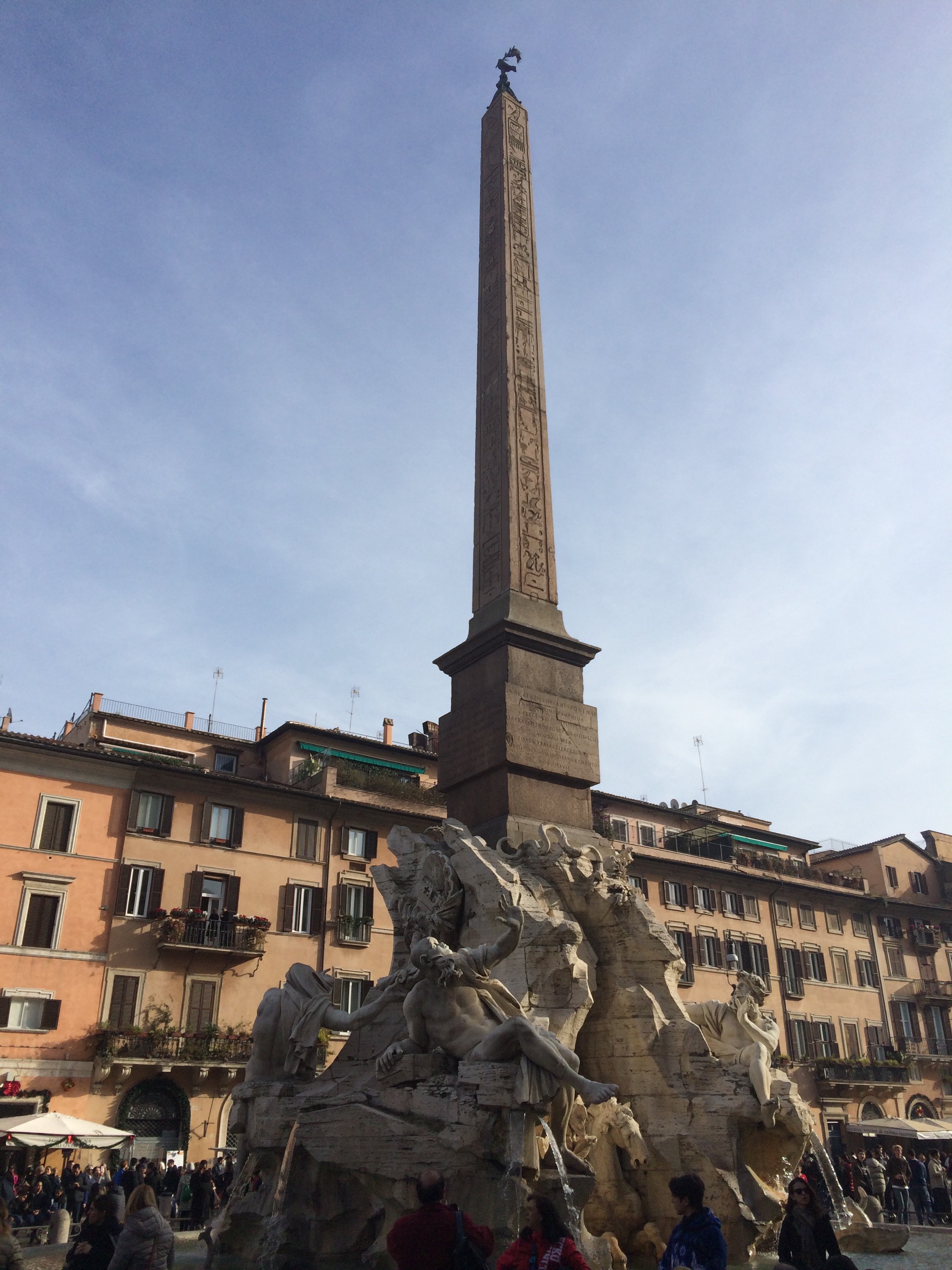 This is the Fontana dei Quattro Fiumi (“Fountain of the Four Rivers”) which I had stupidly confused with the Trevi Fountain. This is the fountain I had always wanted to see. In fact, I went full-Aragorn when I saw it, murmuring, “Long have I desired to look upon the [rivers] of old.”
This is the Fontana dei Quattro Fiumi (“Fountain of the Four Rivers”) which I had stupidly confused with the Trevi Fountain. This is the fountain I had always wanted to see. In fact, I went full-Aragorn when I saw it, murmuring, “Long have I desired to look upon the [rivers] of old.”
It was designed by Bernini in 1651. Beneath yet another Egyptian obelisk, there are four sculptures personifying the four great rivers of the four continents over which papal authority had spread: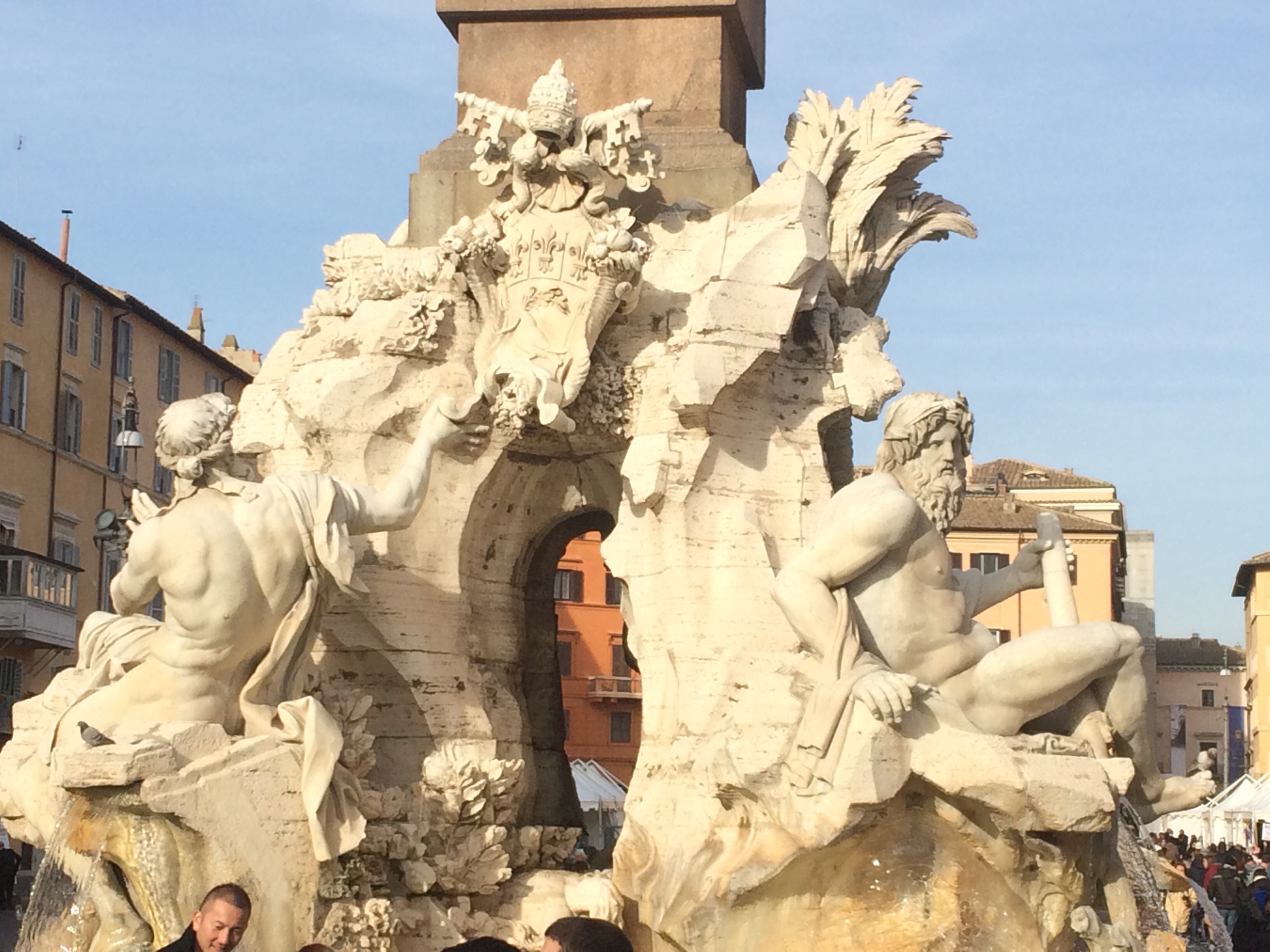 The Ganges representing Asia…
The Ganges representing Asia…
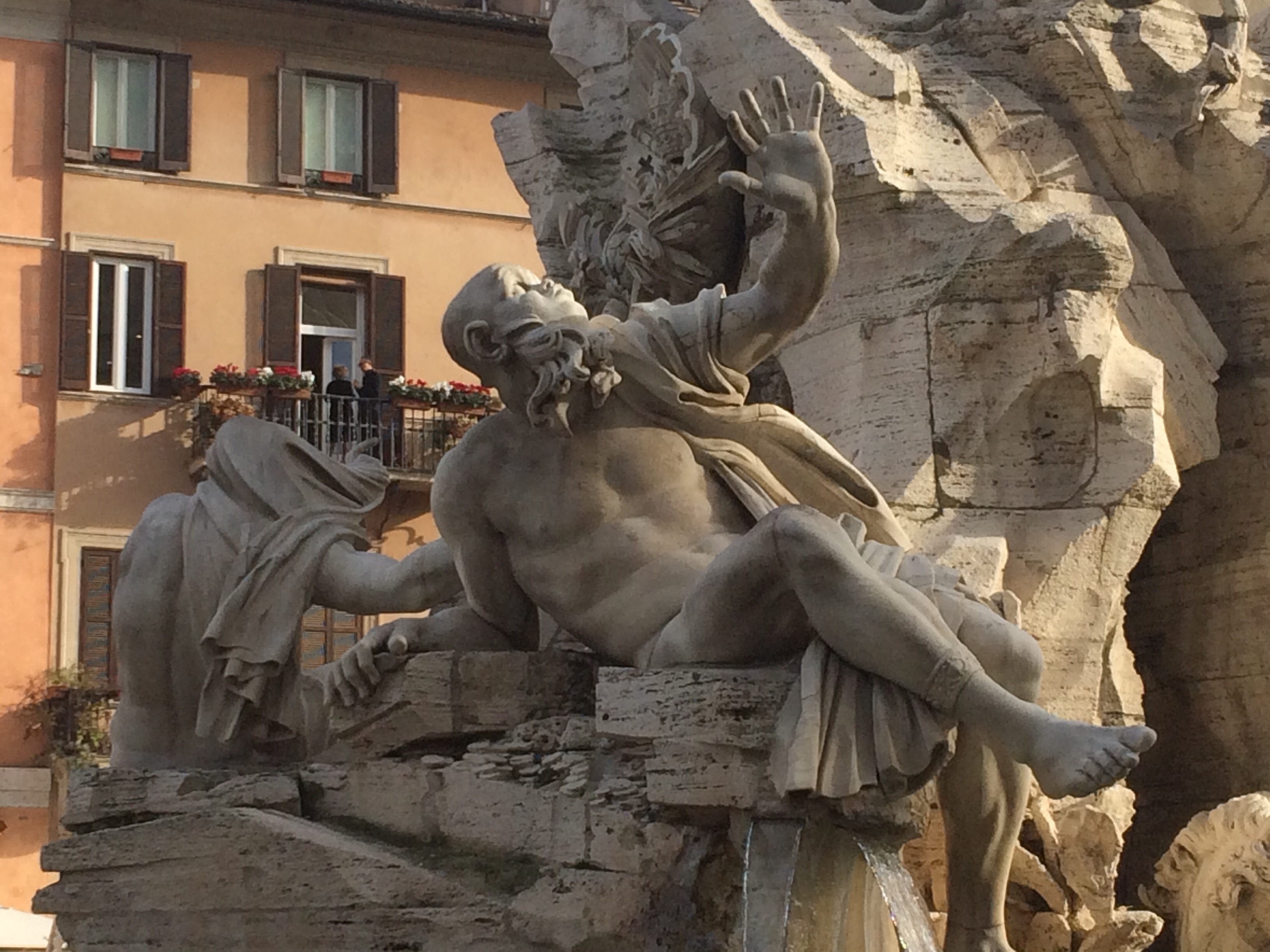 …the Río de la Plata representing the Americas….
…the Río de la Plata representing the Americas…. 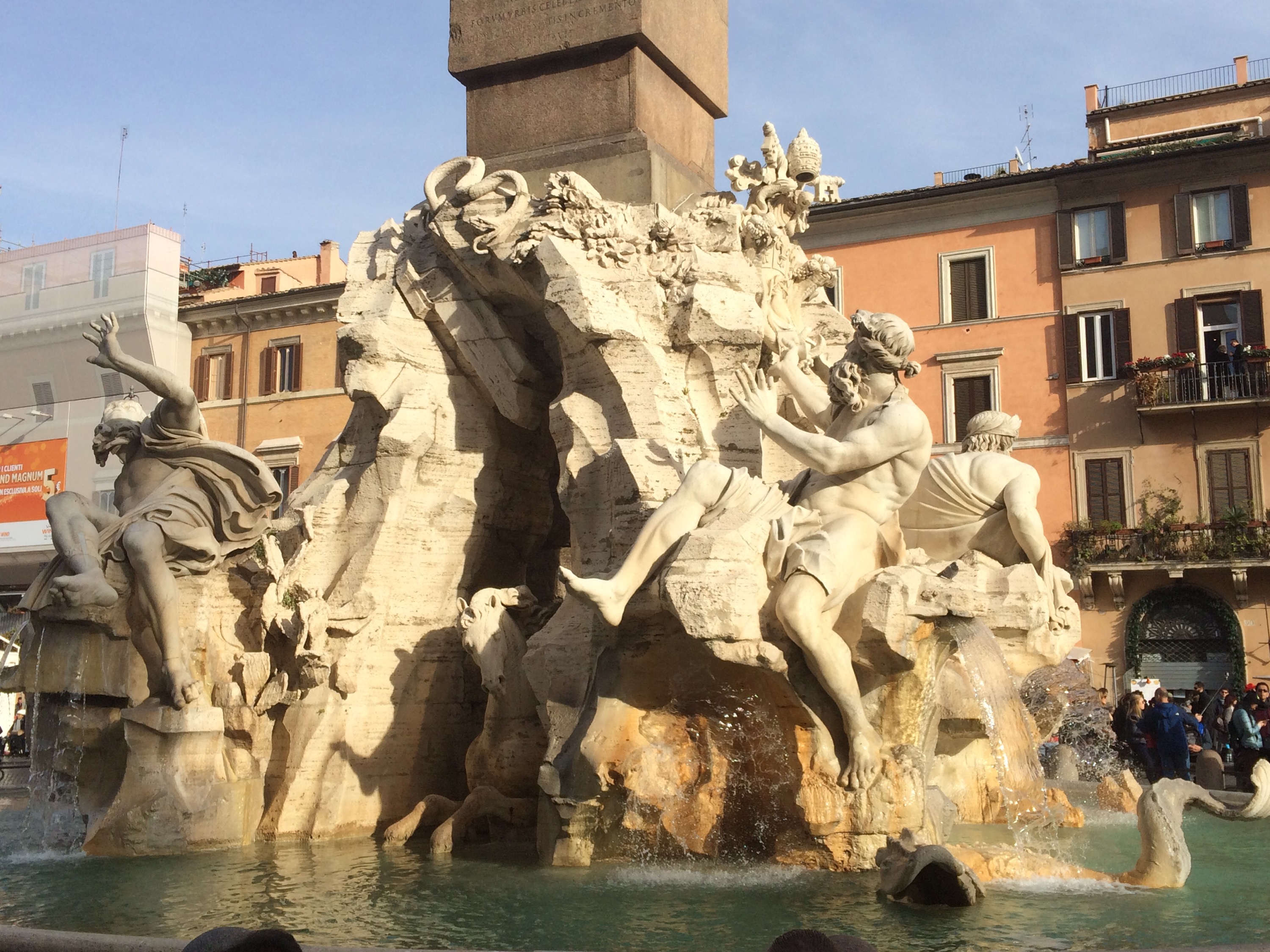 …the Danube representing Europe…
…the Danube representing Europe… 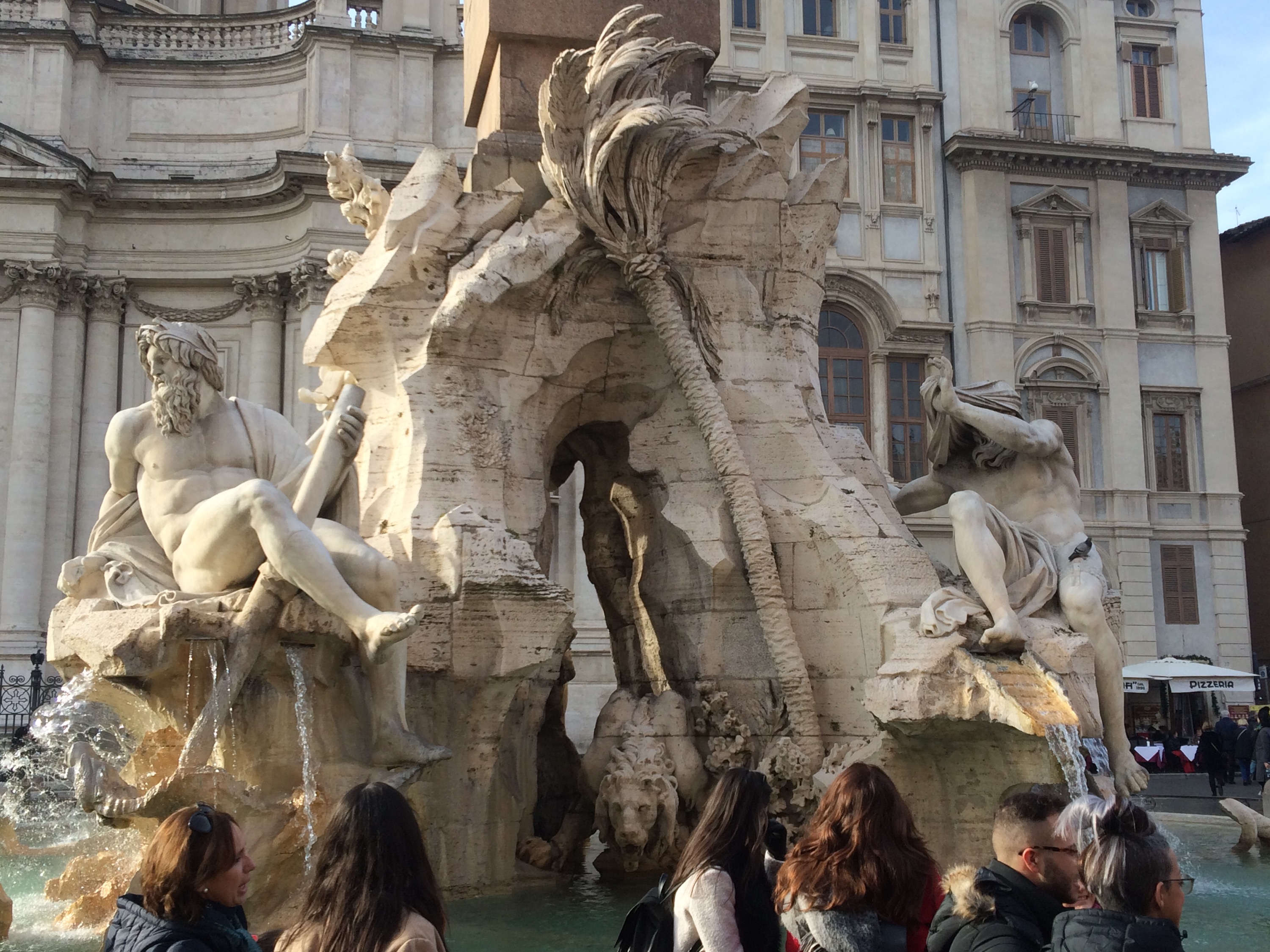 …and the Nile representing Africa.
…and the Nile representing Africa.
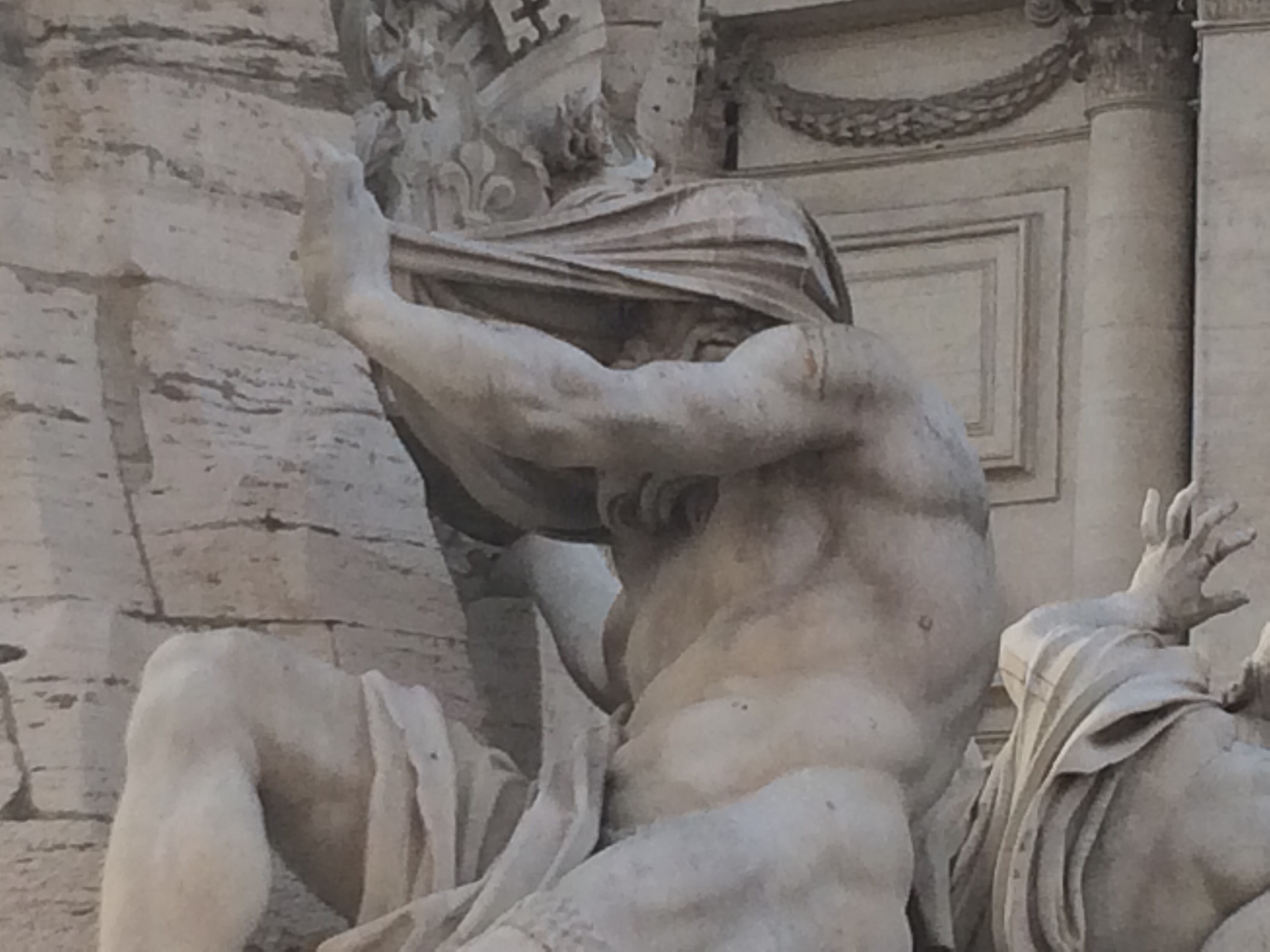 And this is the one I have always wanted to see because I fucking love this: the sculpture of the Nile is depicted with its head covered because, at the time of its sculpting, the source of the Nile was unknown to Europeans.
And this is the one I have always wanted to see because I fucking love this: the sculpture of the Nile is depicted with its head covered because, at the time of its sculpting, the source of the Nile was unknown to Europeans.
Posted in Roma
4 Comments
Padre
 At noon on Easter and Christmas, the Pope steps out on the loggia of St. Peter’s Basilica and delivers the Urbi et Orbi (“to the City of Rome and to the World”) address and blessing. I got to St. Peter’s Square a couple hours early thinking that the crowds would be insane, but, yet again, China had warped my expectations. (I did have a funny China flashback, however, bantering with the polizia at the security checkpoint when they warned me not to hit my head on the top of the metal detector.)
At noon on Easter and Christmas, the Pope steps out on the loggia of St. Peter’s Basilica and delivers the Urbi et Orbi (“to the City of Rome and to the World”) address and blessing. I got to St. Peter’s Square a couple hours early thinking that the crowds would be insane, but, yet again, China had warped my expectations. (I did have a funny China flashback, however, bantering with the polizia at the security checkpoint when they warned me not to hit my head on the top of the metal detector.)
I arrived early enough to get one of the limited number of chairs immediately beneath the loggia. Although, yet again, Disney had warped my expectations through forced perspective and I thought I was going to be much closer to the Pope than I turned out to be.
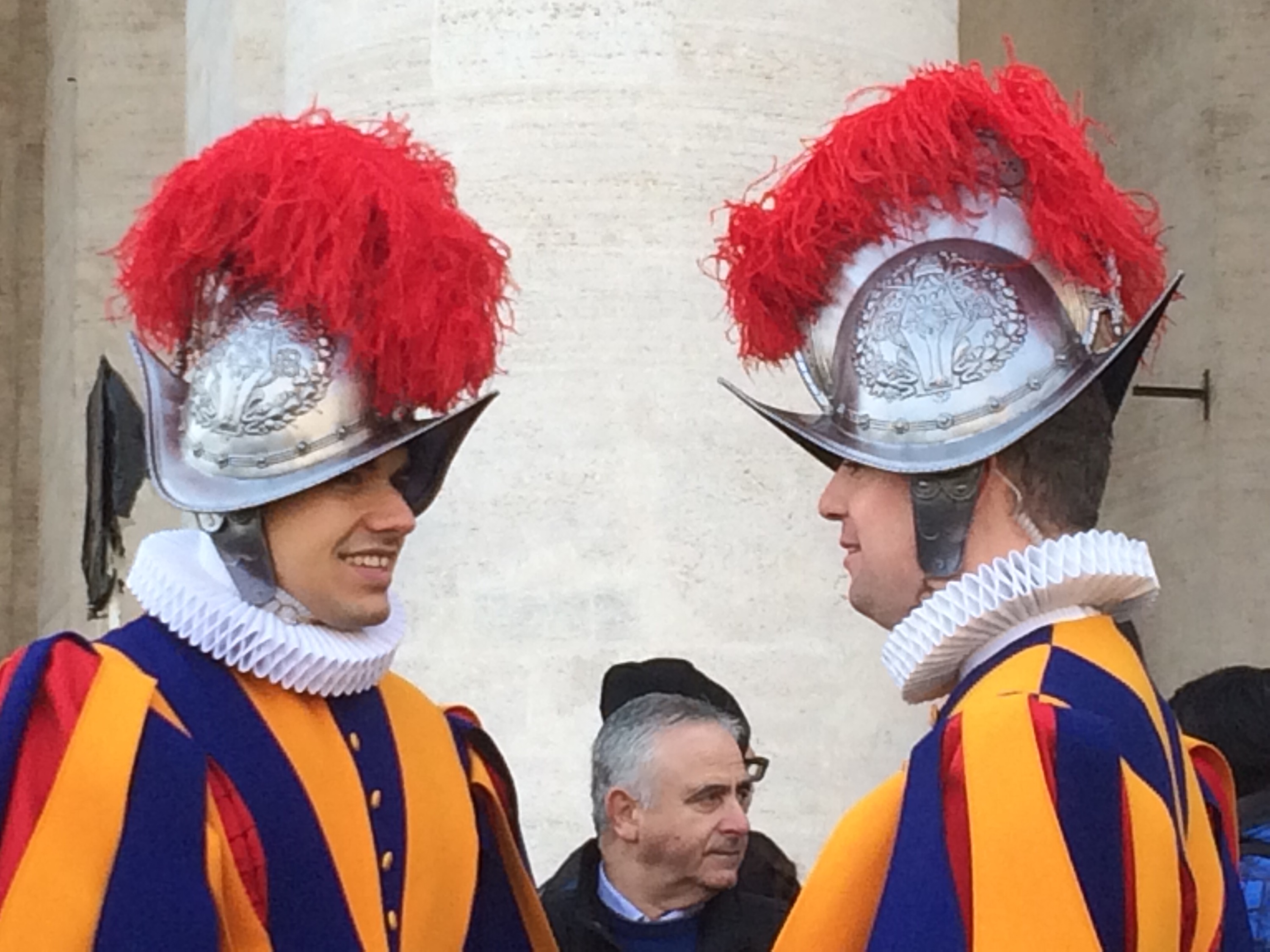 Everyone, even the Swiss Guards, were in good spirits.
Everyone, even the Swiss Guards, were in good spirits. 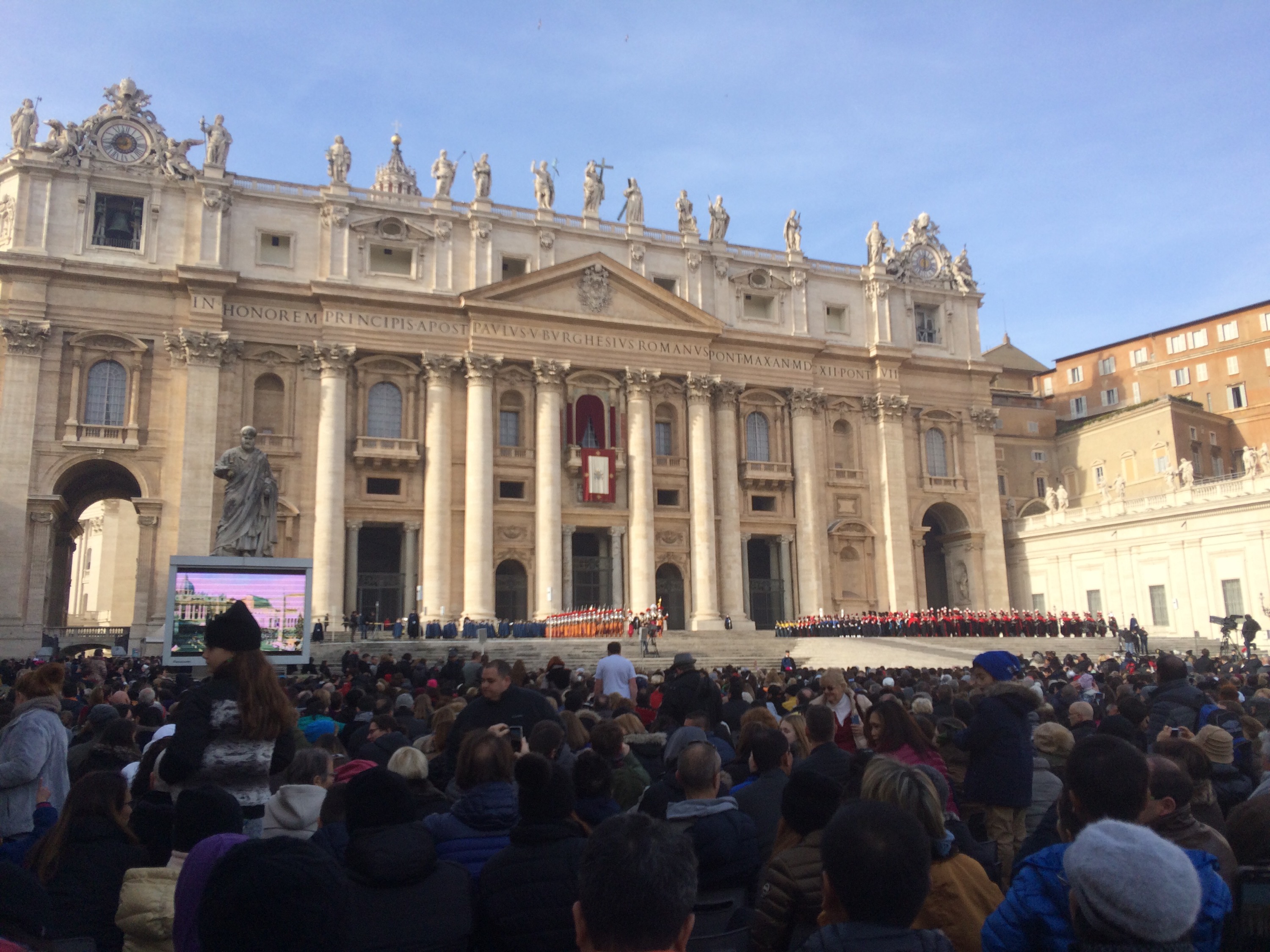 Nearing noon, a band marched forward and arranged themselves with the guard under the loggia.
Nearing noon, a band marched forward and arranged themselves with the guard under the loggia.
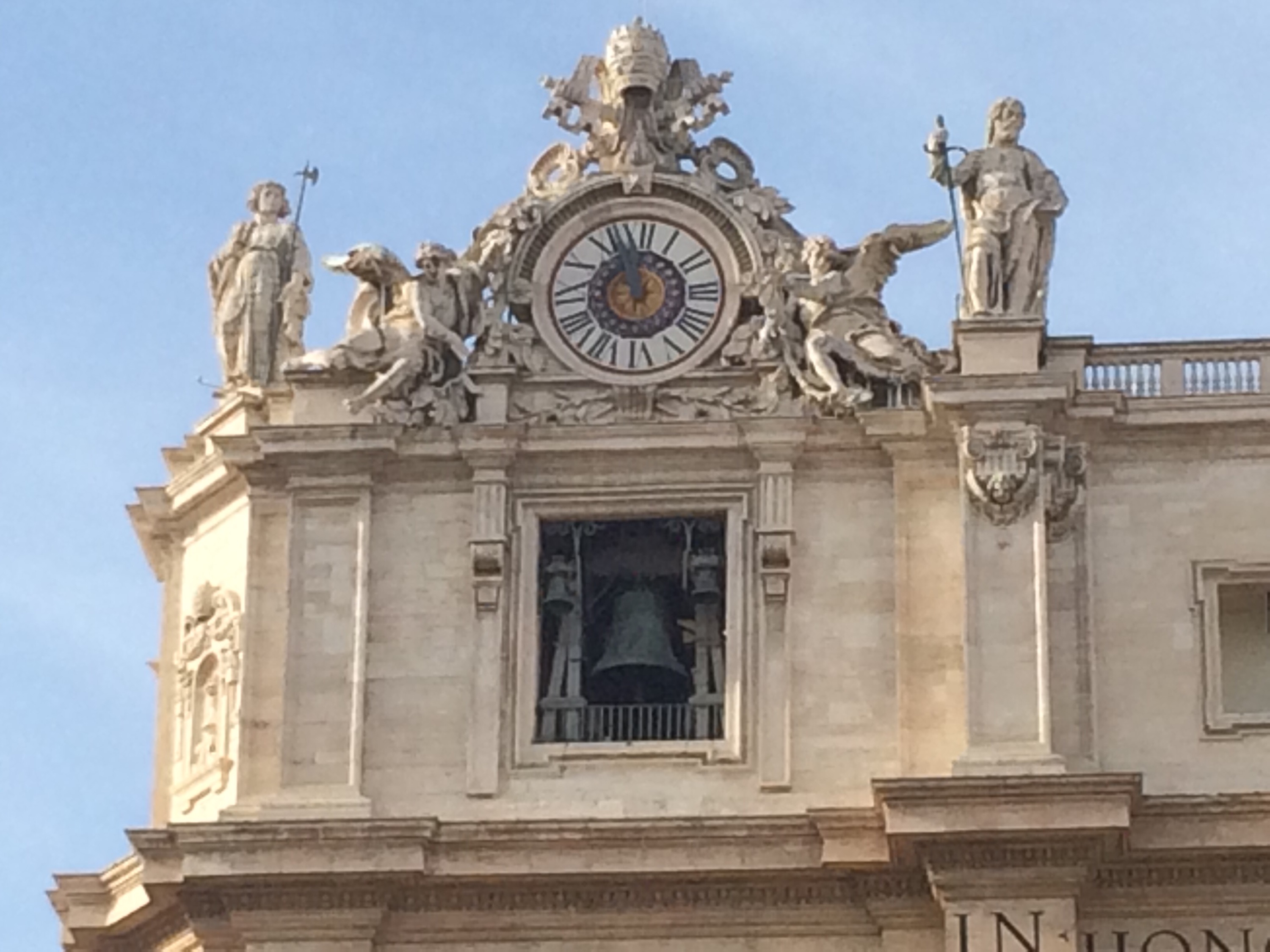 At the stroke of noon…
At the stroke of noon… 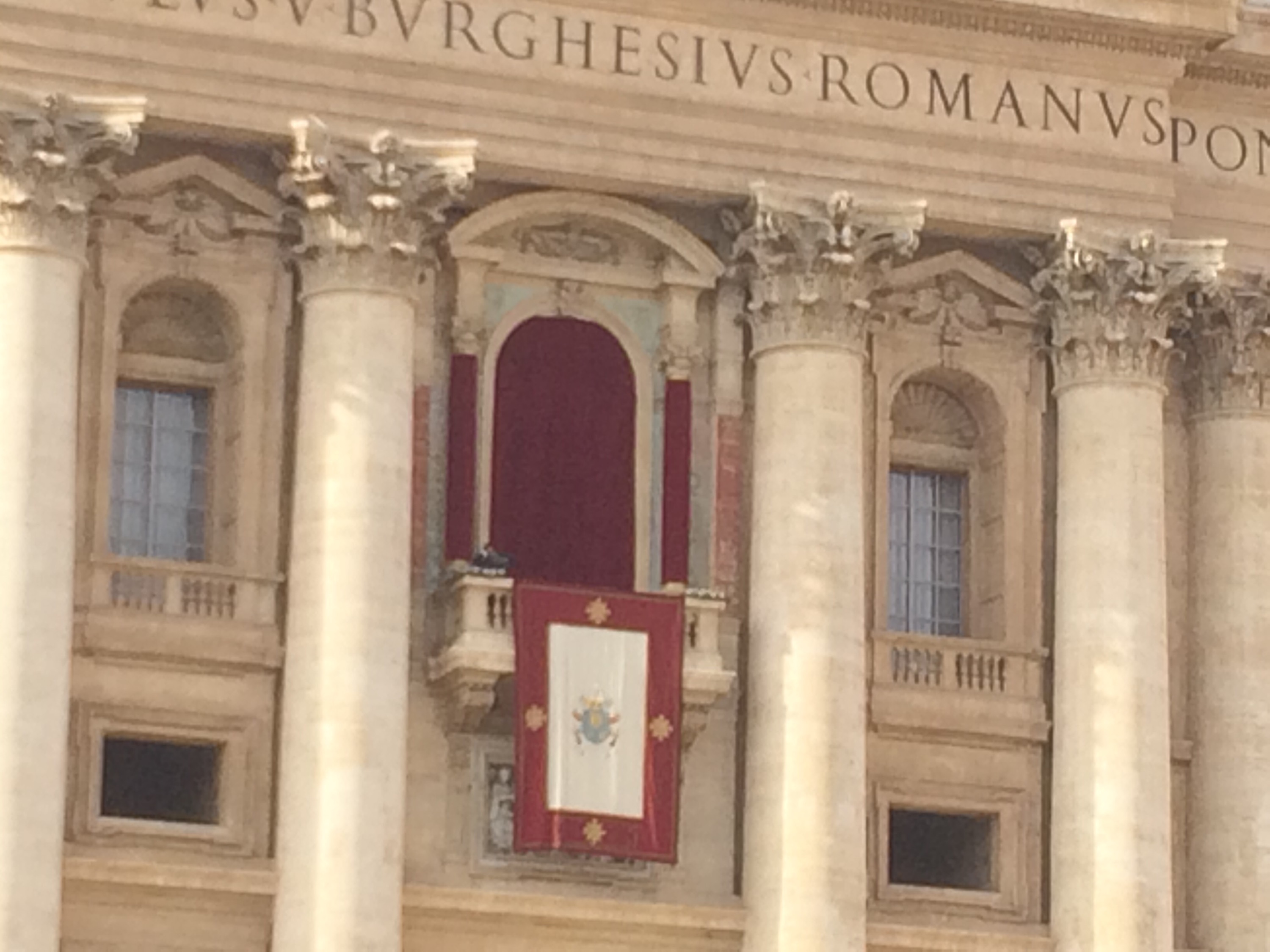 …the curtains parted…
…the curtains parted…
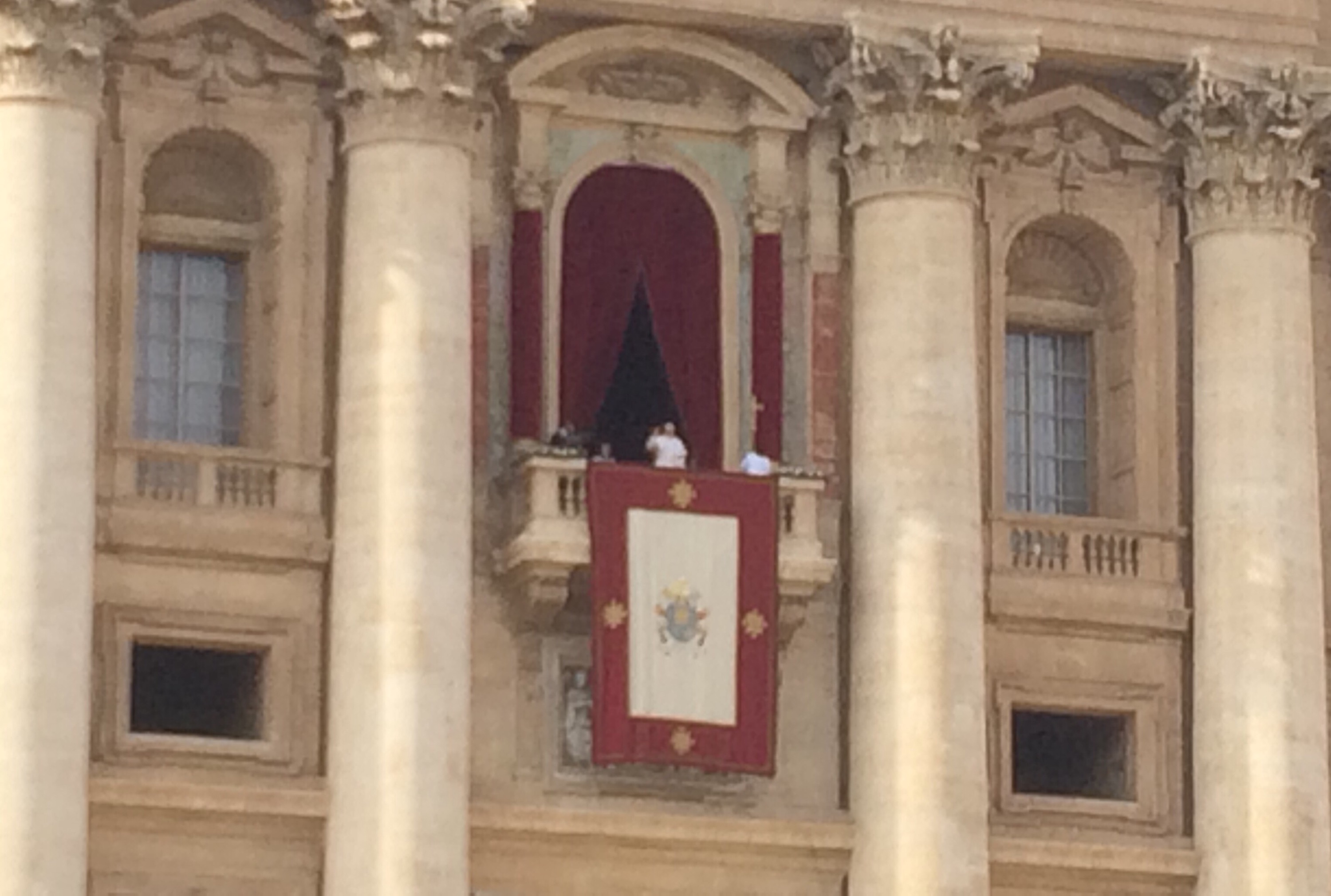 …and Pope Francis stepped out and waved to the cheering crowd. (Man, the Catholic Church has it dialed in on how to make an entrance.)
…and Pope Francis stepped out and waved to the cheering crowd. (Man, the Catholic Church has it dialed in on how to make an entrance.) Other V.I.P.s (cardinals, presumably?) joined him on the loggia.
Other V.I.P.s (cardinals, presumably?) joined him on the loggia.
 The pope read his blessing from a lectern. It lasted about twenty minutes. Couldn’t follow it, but I caught a lot of “pace” and a couple of “bambini”.
The pope read his blessing from a lectern. It lasted about twenty minutes. Couldn’t follow it, but I caught a lot of “pace” and a couple of “bambini”. 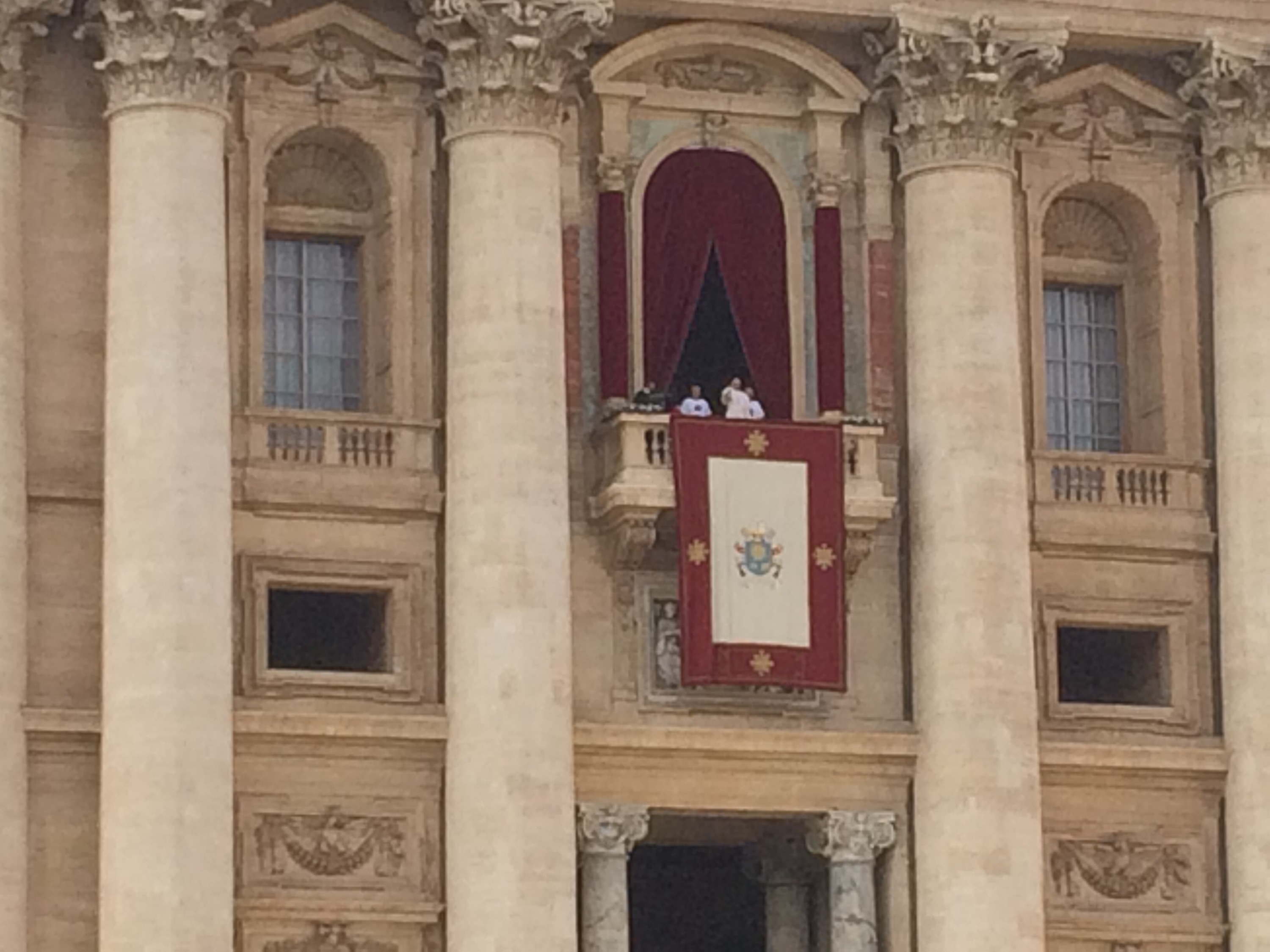 There was some call-and-respsonse boilerplate and then the pope was (literally) “peace out”.
There was some call-and-respsonse boilerplate and then the pope was (literally) “peace out”.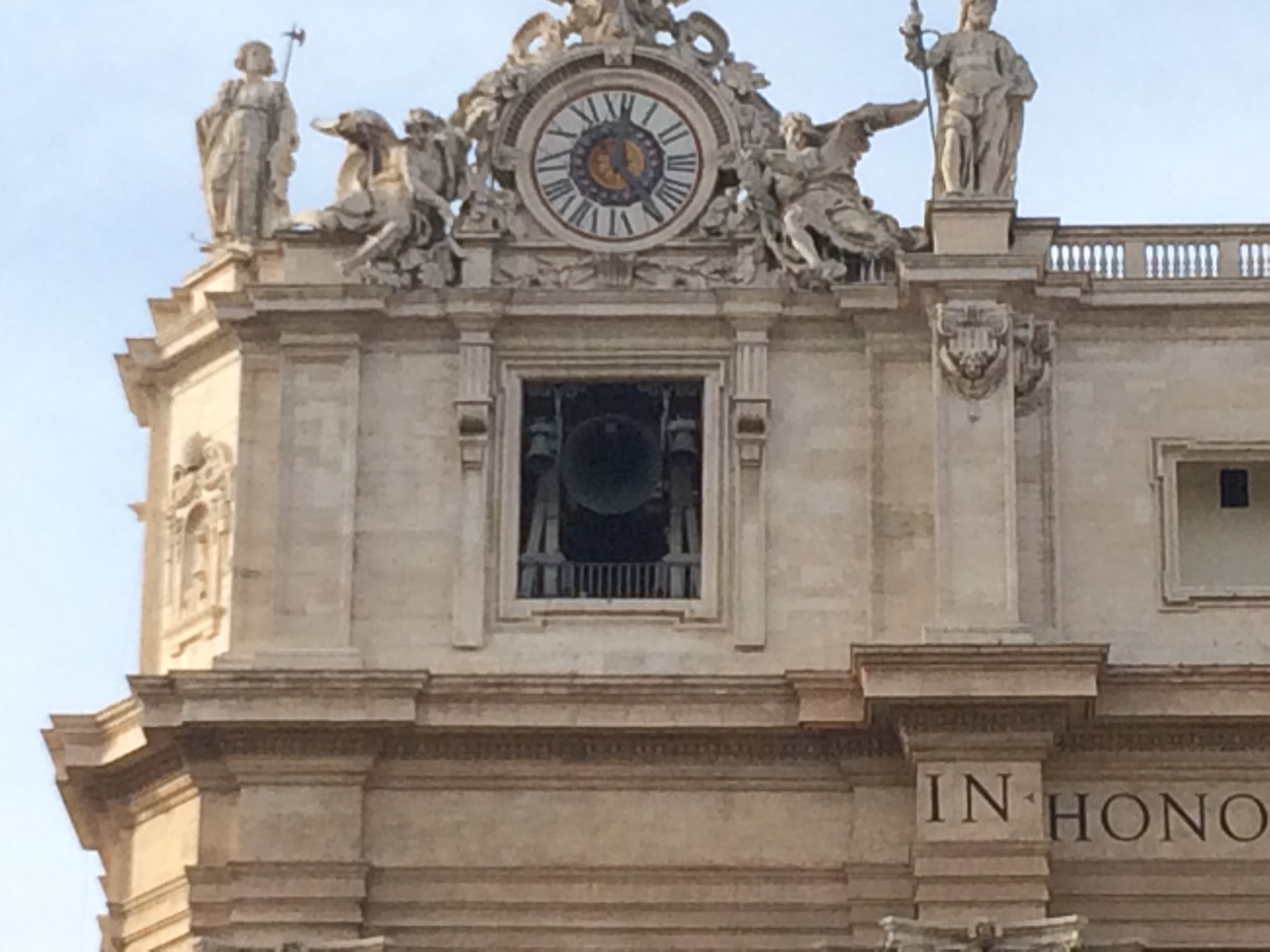 The bells of St. Peter’s rang like crazy.
The bells of St. Peter’s rang like crazy.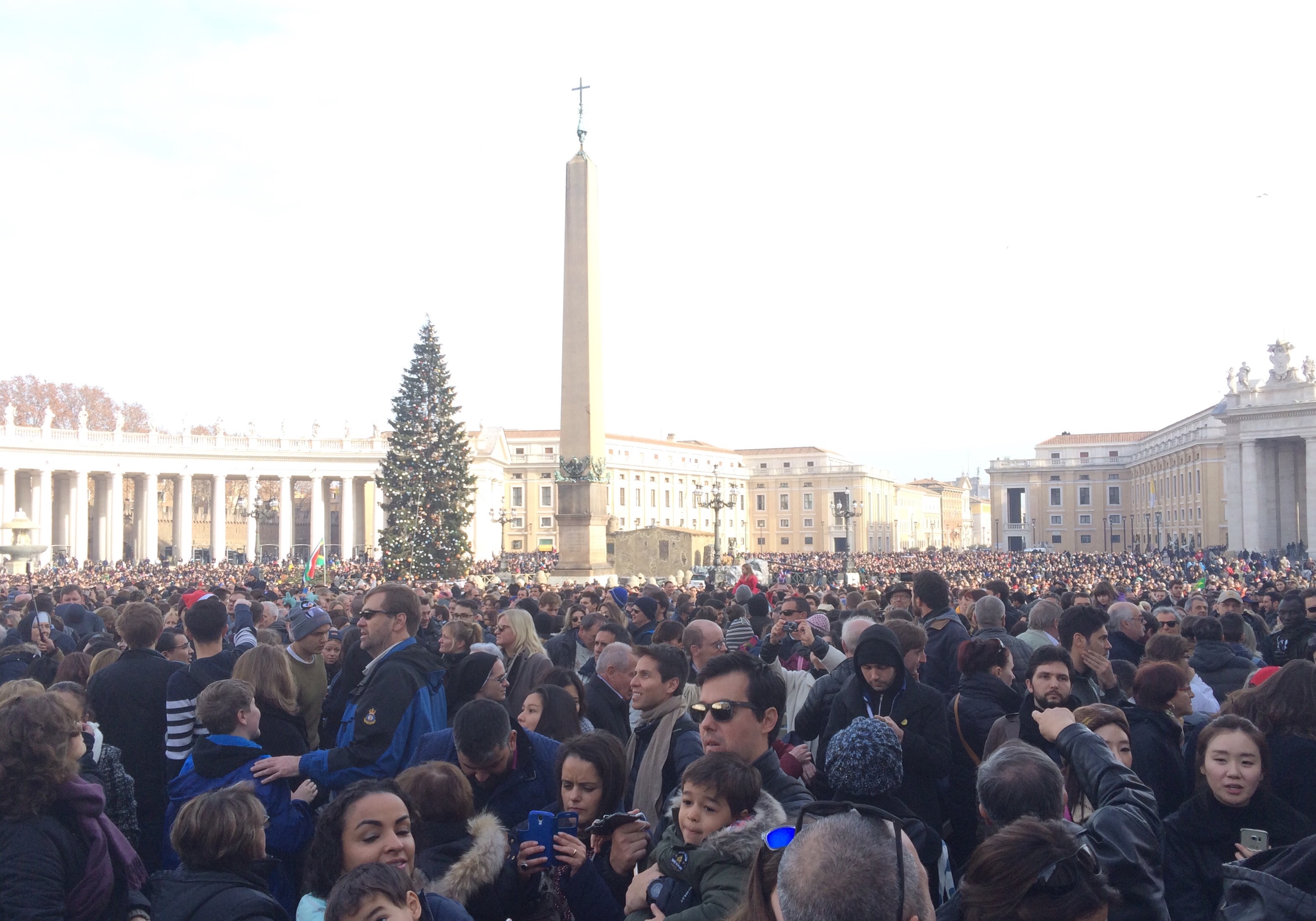 I turned around afterward to find that St. Peter’s Square had filled out nicely. Based on this (and the Lindy Effect) I expect the Catholic Church will be sticking around for a while.
I turned around afterward to find that St. Peter’s Square had filled out nicely. Based on this (and the Lindy Effect) I expect the Catholic Church will be sticking around for a while.
Fondazione
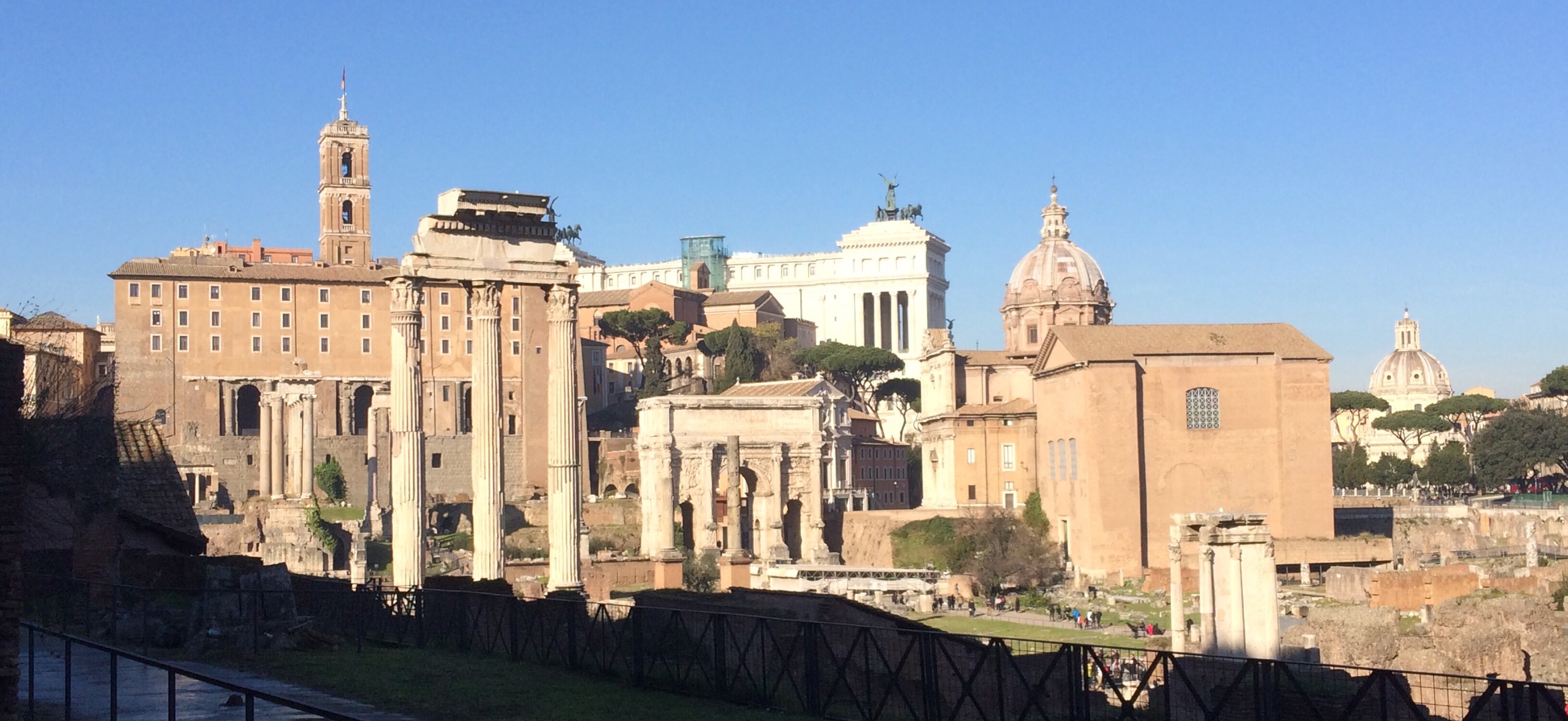 The Roman Forum is a hodgepodge of ancient ruins, some dating back to the 8th century B.C.E., in a small valley between the Palatine and Capitoline Hills.
The Roman Forum is a hodgepodge of ancient ruins, some dating back to the 8th century B.C.E., in a small valley between the Palatine and Capitoline Hills.
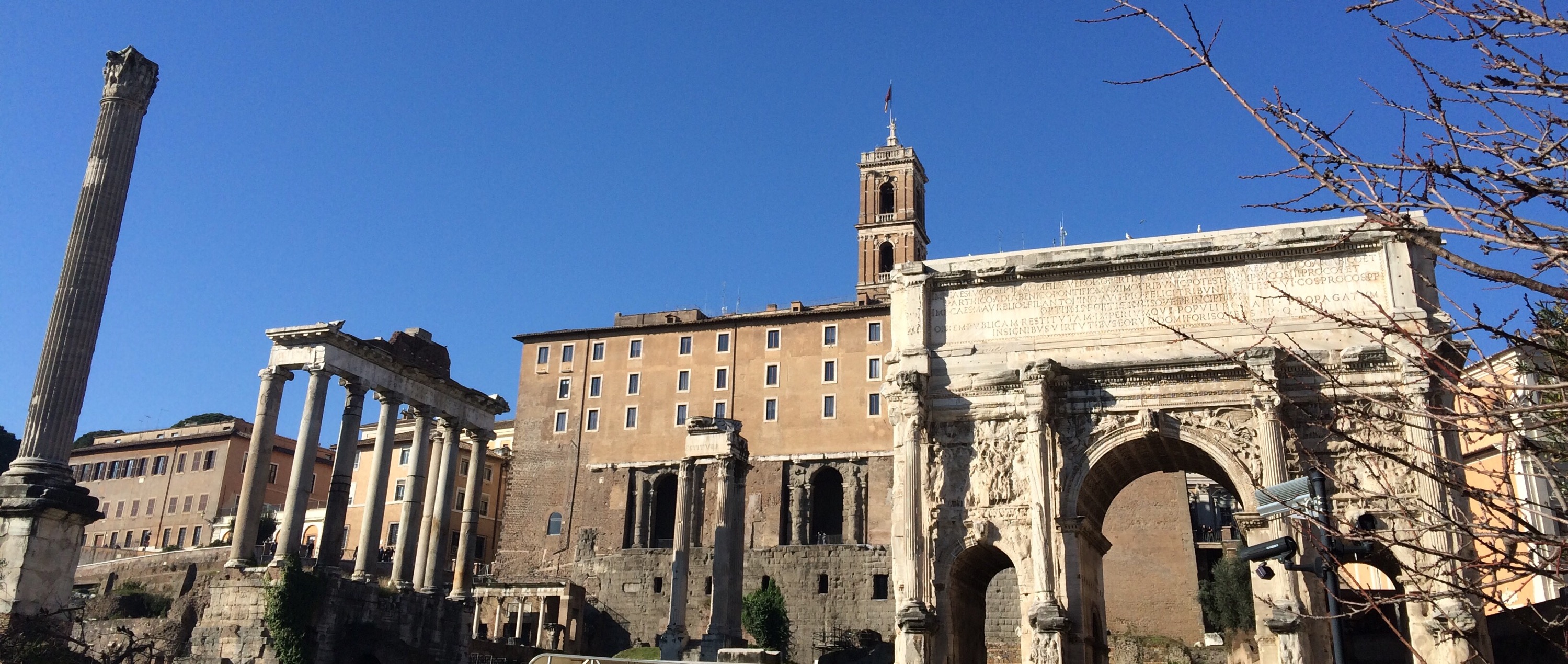 I have never felt such an overwhelming density of history. There are artefacts from the Roman Kingdom, Roman Republic, and Roman Empire which have all survived to the modern day. Staggering.
I have never felt such an overwhelming density of history. There are artefacts from the Roman Kingdom, Roman Republic, and Roman Empire which have all survived to the modern day. Staggering.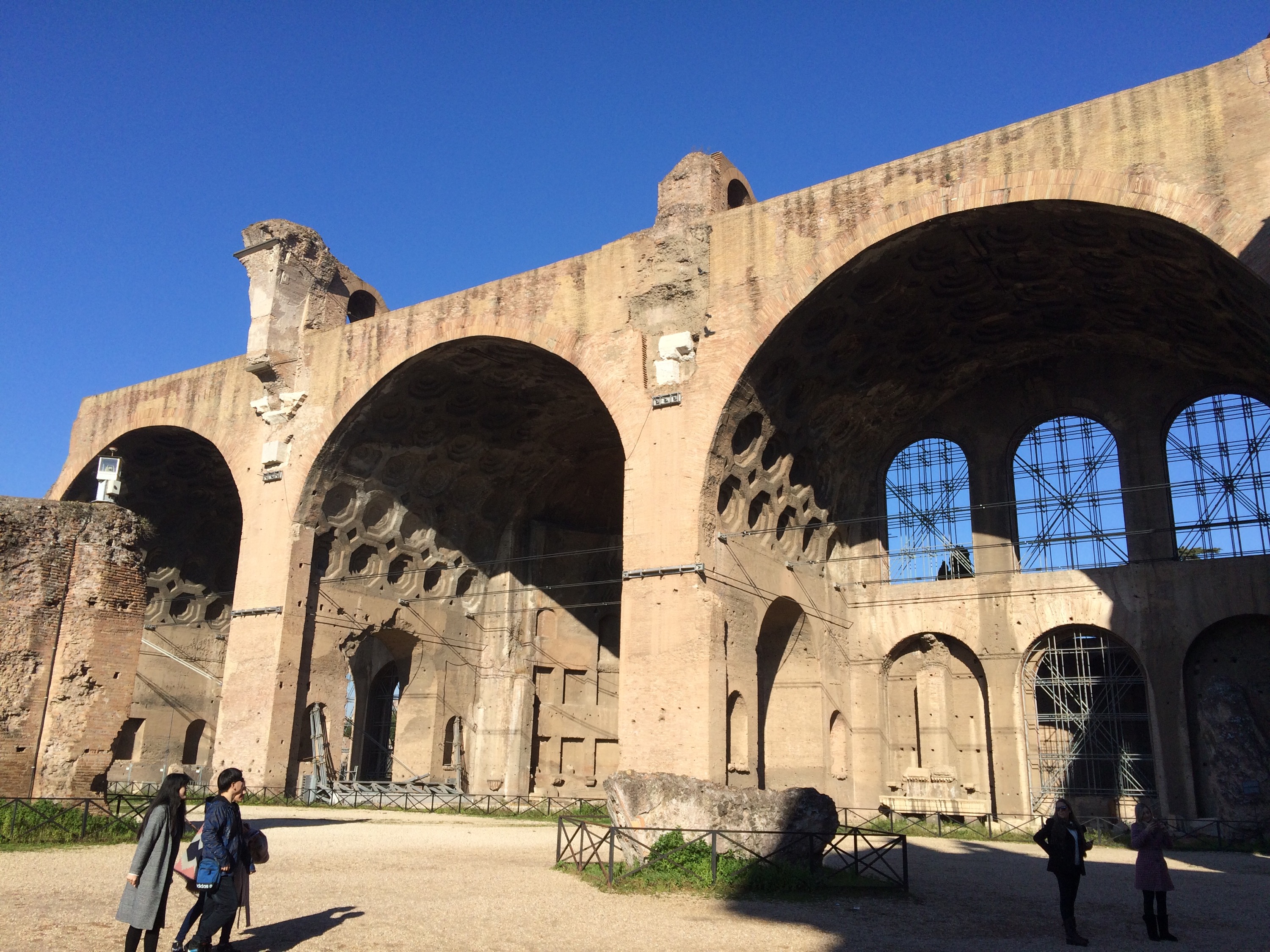 The last — and largest — of the structures added to the Forum was the Basilica of Maxentius built by Constantine.
The last — and largest — of the structures added to the Forum was the Basilica of Maxentius built by Constantine.
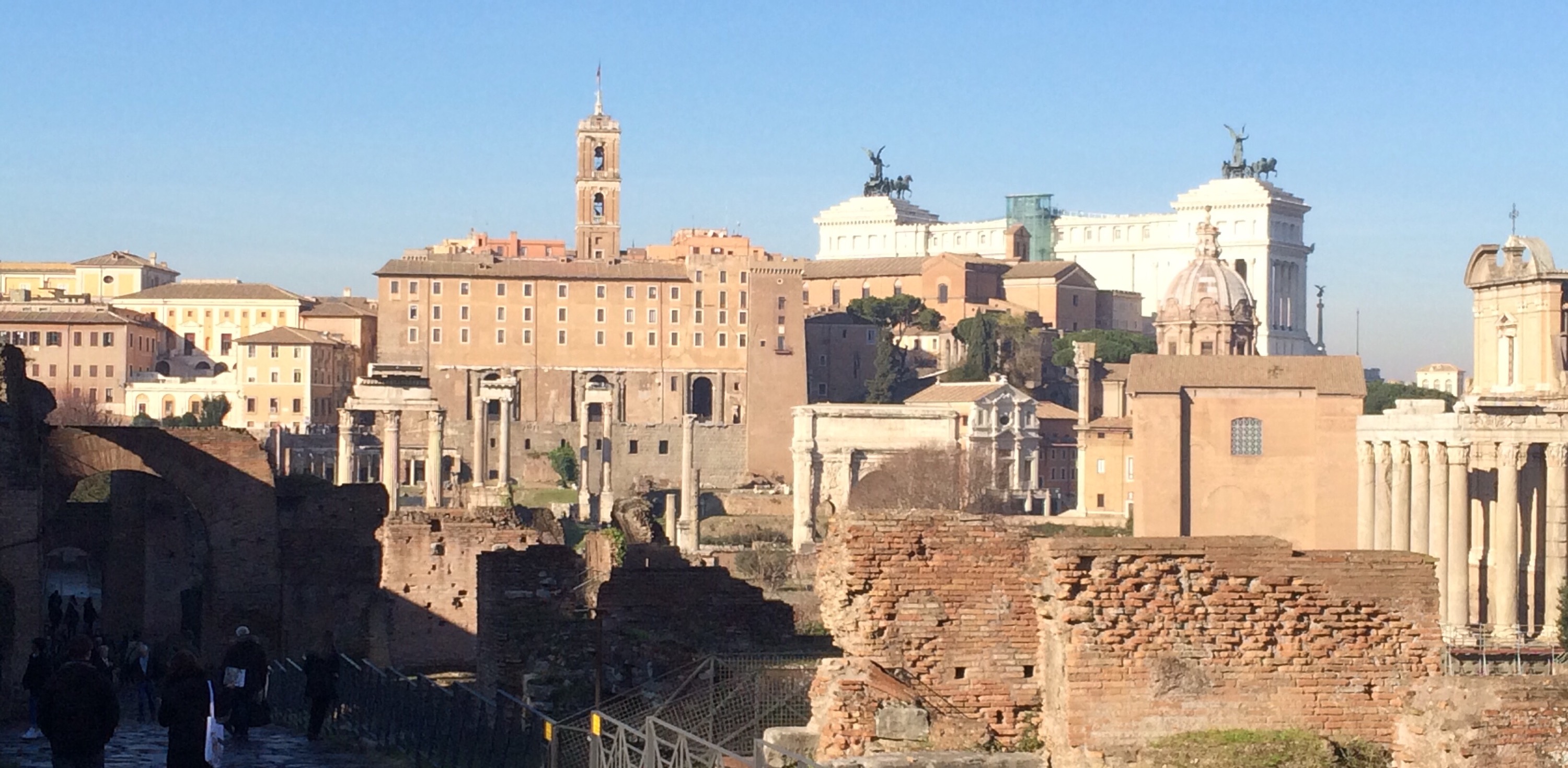 Looking out at the free-standing columns and rubble, I couldn’t help but think of Michael Whelan‘s painting Trantorian Dream.
Looking out at the free-standing columns and rubble, I couldn’t help but think of Michael Whelan‘s painting Trantorian Dream.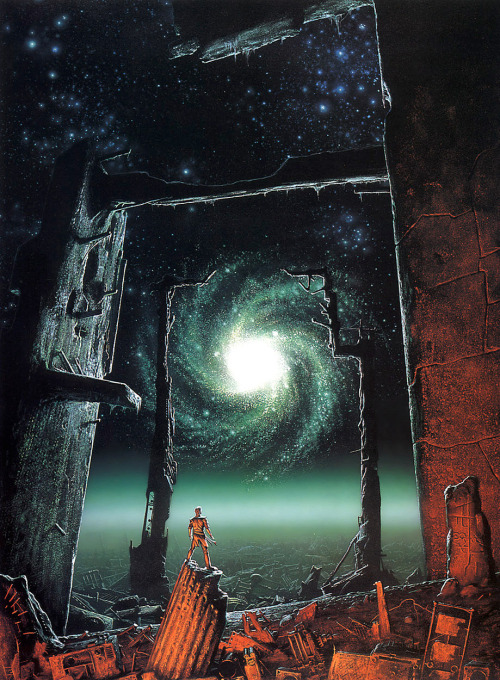
Fitting, since Asimov‘s Foundation series was inspired by Gibbon‘s The History of the Decline and Fall of the Roman Empire.

